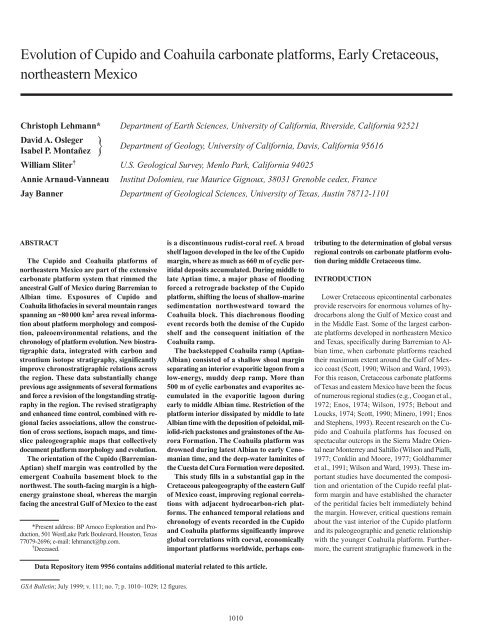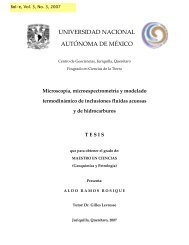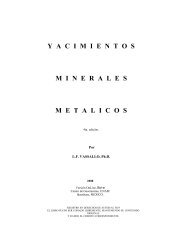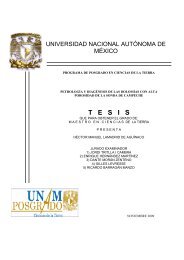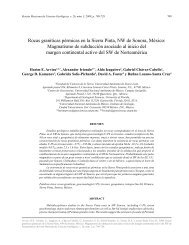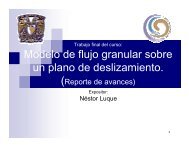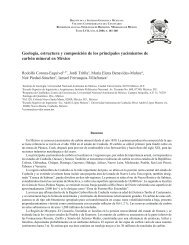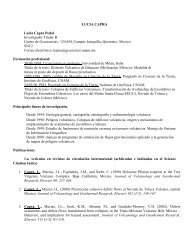Evolution of Cupido and Coahuila carbonate platforms, Early ...
Evolution of Cupido and Coahuila carbonate platforms, Early ...
Evolution of Cupido and Coahuila carbonate platforms, Early ...
Create successful ePaper yourself
Turn your PDF publications into a flip-book with our unique Google optimized e-Paper software.
<strong>Evolution</strong> <strong>of</strong> <strong>Cupido</strong> <strong>and</strong> <strong>Coahuila</strong> <strong>carbonate</strong> <strong>platforms</strong>, <strong>Early</strong> Cretaceous,northeastern MexicoChristoph Lehmann* Department <strong>of</strong> Earth Sciences, University <strong>of</strong> California, Riverside, California 92521David A. OslegerIsabel P. Montañez } Department <strong>of</strong> Geology, University <strong>of</strong> California, Davis, California 95616William Sliter † U.S. Geological Survey, Menlo Park, California 94025Annie Arnaud-Vanneau Institut Dolomieu, rue Maurice Gignoux, 38031 Grenoble cedex, FranceJay Banner Department <strong>of</strong> Geological Sciences, University <strong>of</strong> Texas, Austin 78712-1101ABSTRACTThe <strong>Cupido</strong> <strong>and</strong> <strong>Coahuila</strong> <strong>platforms</strong> <strong>of</strong>northeastern Mexico are part <strong>of</strong> the extensive<strong>carbonate</strong> platform system that rimmed theancestral Gulf <strong>of</strong> Mexico during Barremian toAlbian time. Exposures <strong>of</strong> <strong>Cupido</strong> <strong>and</strong><strong>Coahuila</strong> lith<strong>of</strong>acies in several mountain rangesspanning an ~80 000 km 2 area reveal informationabout platform morphology <strong>and</strong> composition,paleoenvironmental relations, <strong>and</strong> thechronology <strong>of</strong> platform evolution. New biostratigraphicdata, integrated with carbon <strong>and</strong>strontium isotope stratigraphy, significantlyimprove chronostratigraphic relations acrossthe region. These data substantially changeprevious age assignments <strong>of</strong> several formations<strong>and</strong> force a revision <strong>of</strong> the longst<strong>and</strong>ing stratigraphyin the region. The revised stratigraphy<strong>and</strong> enhanced time control, combined with regionalfacies associations, allow the construction<strong>of</strong> cross sections, isopach maps, <strong>and</strong> timeslicepaleogeographic maps that collectivelydocument platform morphology <strong>and</strong> evolution.The orientation <strong>of</strong> the <strong>Cupido</strong> (Barremian-Aptian) shelf margin was controlled by theemergent <strong>Coahuila</strong> basement block to thenorthwest. The south-facing margin is a highenergygrainstone shoal, whereas the marginfacing the ancestral Gulf <strong>of</strong> Mexico to the east*Present address: BP Amoco Exploration <strong>and</strong> Production,501 WestLake Park Boulevard, Houston, Texas77079-2696; e-mail: lehmanct@bp.com.† Deceased.is a discontinuous rudist-coral reef. A broadshelf lagoon developed in the lee <strong>of</strong> the <strong>Cupido</strong>margin, where as much as 660 m <strong>of</strong> cyclic peritidaldeposits accumulated. During middle tolate Aptian time, a major phase <strong>of</strong> floodingforced a retrograde backstep <strong>of</strong> the <strong>Cupido</strong>platform, shifting the locus <strong>of</strong> shallow-marinesedimentation northwestward toward the<strong>Coahuila</strong> block. This diachronous floodingevent records both the demise <strong>of</strong> the <strong>Cupido</strong>shelf <strong>and</strong> the consequent initiation <strong>of</strong> the<strong>Coahuila</strong> ramp.The backstepped <strong>Coahuila</strong> ramp (Aptian-Albian) consisted <strong>of</strong> a shallow shoal marginseparating an interior evaporitic lagoon from alow-energy, muddy deep ramp. More than500 m <strong>of</strong> cyclic <strong>carbonate</strong>s <strong>and</strong> evaporites accumulatedin the evaporitic lagoon duringearly to middle Albian time. Restriction <strong>of</strong> theplatform interior dissipated by middle to lateAlbian time with the deposition <strong>of</strong> peloidal, miliolid-richpackstones <strong>and</strong> grainstones <strong>of</strong> the AuroraFormation. The <strong>Coahuila</strong> platform wasdrowned during latest Albian to early Cenomaniantime, <strong>and</strong> the deep-water laminites <strong>of</strong>the Cuesta del Cura Formation were deposited.This study fills in a substantial gap in theCretaceous paleogeography <strong>of</strong> the eastern Gulf<strong>of</strong> Mexico coast, improving regional correlationswith adjacent hydrocarbon-rich <strong>platforms</strong>.The enhanced temporal relations <strong>and</strong>chronology <strong>of</strong> events recorded in the <strong>Cupido</strong><strong>and</strong> <strong>Coahuila</strong> <strong>platforms</strong> significantly improveglobal correlations with coeval, economicallyimportant <strong>platforms</strong> worldwide, perhaps contributingto the determination <strong>of</strong> global versusregional controls on <strong>carbonate</strong> platform evolutionduring middle Cretaceous time.INTRODUCTIONLower Cretaceous epicontinental <strong>carbonate</strong>sprovide reservoirs for enormous volumes <strong>of</strong> hydrocarbonsalong the Gulf <strong>of</strong> Mexico coast <strong>and</strong>in the Middle East. Some <strong>of</strong> the largest <strong>carbonate</strong><strong>platforms</strong> developed in northeastern Mexico<strong>and</strong> Texas, specifically during Barremian to Albiantime, when <strong>carbonate</strong> <strong>platforms</strong> reachedtheir maximum extent around the Gulf <strong>of</strong> Mexicocoast (Scott, 1990; Wilson <strong>and</strong> Ward, 1993).For this reason, Cretaceous <strong>carbonate</strong> <strong>platforms</strong><strong>of</strong> Texas <strong>and</strong> eastern Mexico have been the focus<strong>of</strong> numerous regional studies (e.g., Coogan et al.,1972; Enos, 1974; Wilson, 1975; Bebout <strong>and</strong>Loucks, 1974; Scott, 1990; Minero, 1991; Enos<strong>and</strong> Stephens, 1993). Recent research on the <strong>Cupido</strong><strong>and</strong> <strong>Coahuila</strong> <strong>platforms</strong> has focused onspectacular outcrops in the Sierra Madre Orientalnear Monterrey <strong>and</strong> Saltillo (Wilson <strong>and</strong> Pialli,1977; Conklin <strong>and</strong> Moore, 1977; Goldhammeret al., 1991; Wilson <strong>and</strong> Ward, 1993). These importantstudies have documented the composition<strong>and</strong> orientation <strong>of</strong> the <strong>Cupido</strong> reefal platformmargin <strong>and</strong> have established the character<strong>of</strong> the peritidal facies belt immediately behindthe margin. However, critical questions remainabout the vast interior <strong>of</strong> the <strong>Cupido</strong> platform<strong>and</strong> its paleogeographic <strong>and</strong> genetic relationshipwith the younger <strong>Coahuila</strong> platform. Furthermore,the current stratigraphic framework in theData Repository item 9956 contains additional material related to this article.GSA Bulletin; July 1999; v. 111; no. 7; p. 1010–1029; 12 figures.1010
LOWER CRETACEOUS CARBONATE PLATFORM EVOLUTION, STRATIGRAPHY, MEXICOstudy area is marked by equivocal age assignments,<strong>and</strong> thus there may be miscorrelations.To attain a more complete regional underst<strong>and</strong>ing<strong>of</strong> these two <strong>platforms</strong>, we focused onremote <strong>and</strong> relatively uninvestigated exposures tothe west <strong>and</strong> northwest in the Sierra de Parras <strong>and</strong>above the <strong>Coahuila</strong> basement block. The objectives<strong>of</strong> this study were to (1) document paleogeographic<strong>and</strong> large-scale facies relationshipsacross northeastern Mexico for Barremian to Albianstrata, (2) obtain new biostratigraphic <strong>and</strong>chemostratigraphic information to refine chronostratigraphicrelationships, <strong>and</strong> (3) use these datato interpret the evolutionary development <strong>of</strong>these Lower Cretaceous <strong>platforms</strong>.The results <strong>of</strong> this study have important implicationsfor our underst<strong>and</strong>ing <strong>of</strong> the <strong>Early</strong>Cretaceous evolution <strong>of</strong> the Gulf <strong>of</strong> Mexicocoast region. First, the new biostratigraphicdata, integrated with carbon <strong>and</strong> strontium isotopestratigraphy, dictate a substantial revision<strong>of</strong> the longst<strong>and</strong>ing stratigraphic framework inthe study area. In addition, this study fills in asubstantial hole in the data for the Cretaceouspaleogeography <strong>of</strong> the eastern Gulf <strong>of</strong> Mexicocoast, improving regional correlations with adjacenthydrocarbon-rich <strong>platforms</strong> to the southin eastern Mexico (Valles–Golden Lane) <strong>and</strong> tothe north in Texas (Sligo-Comanche). Perhapsmost important, the high-resolution chronology<strong>of</strong> the evolution <strong>of</strong> the <strong>Cupido</strong> <strong>and</strong> <strong>Coahuila</strong><strong>platforms</strong> can be compared to coeval <strong>platforms</strong>worldwide to search for connections <strong>and</strong> distinctions,contributing to an enhanced underst<strong>and</strong>ing<strong>of</strong> global versus regional controls on<strong>carbonate</strong> platform development.PALEOTECTONIC EVOLUTION ANDGEOLOGIC SETTINGThe distribution <strong>of</strong> Lower Cretaceous <strong>carbonate</strong><strong>platforms</strong> in northeastern Mexico (Fig. 1) isclosely linked to the opening <strong>of</strong> the Gulf <strong>of</strong> Mexico(Anderson <strong>and</strong> Schmidt, 1983; Winker <strong>and</strong>Buffler, 1988; Wilson, 1990). Late Triassic toMiddle Jurassic extensional rifting <strong>and</strong> strike-slipfaulting produced a mosaic <strong>of</strong> fault blocks (Wilson,1990; <strong>Coahuila</strong>, Picachos, Tamaulipas) <strong>and</strong> interveninggrabens in which lacustrine <strong>and</strong> alluvialfanredbeds, evaporites, <strong>and</strong> clastic strata accumulated(Ovianki, 1974; Padilla y Sanchez, 1982;Salvador, 1987; Wilson, 1990; Michalzik, 1991;Michalzik <strong>and</strong> Schumann, 1994). The <strong>Coahuila</strong>basement block (Fig. 1) is composed <strong>of</strong> granite<strong>and</strong> granodiorite <strong>of</strong> Permian-Triassic age intrudedinto Permian orogenic sediments <strong>and</strong> appears tohave been a peninsular extension <strong>of</strong> the earlyMesozoic craton (Wilson et al., 1984; Wilson,1990). The block is bounded on the north by theleft-lateral San Marcos fault (McKee et al., 1990),<strong>and</strong> on the south by the left-lateral Torreon-Monterrey lineament (parallel with the trend <strong>of</strong>the Sonora-Mojave megashear) (Anderson <strong>and</strong>Schmidt, 1983). The Sonora-Mojave megashearis inferred to have extended to the east, bisectingthe Tamaulipas block <strong>and</strong> the Picachos block(Wilson, 1990). Left-lateral shear zones are interpretedto have been major intracontinental transformfaults that were active during Late Triassic toMiddle Jurassic time, but were likely inactive during<strong>carbonate</strong> deposition in Barremian throughAlbian time (Wilson, 1990; Goldhammer <strong>and</strong>Wilson, 1991).During Late Jurassic time, sea-floor spreadingstarted in the Gulf <strong>of</strong> Mexico (Buffler <strong>and</strong>Sawyer, 1985; Winker <strong>and</strong> Buffler, 1988), <strong>and</strong>nearshore siliciclastic <strong>and</strong> <strong>carbonate</strong> deposits (LaGloria <strong>and</strong> Zuloaga Formations) accumulatednear basement highs, passing into <strong>of</strong>fshore <strong>carbonate</strong>shoals <strong>and</strong> outer-ramp muds (ZuloagaFormation; Meyer <strong>and</strong> Ward, 1984; Johnson,1991). Evaporites <strong>and</strong> mudstones <strong>of</strong> the OlvidoFormation were deposited conformably on theZuloaga Formation during continuous flooding.These initial marine <strong>carbonate</strong> deposits wereterminated with deposition <strong>of</strong> siliciclastics <strong>and</strong>lime mudstones <strong>of</strong> the La Casita Formation duringLate Jurassic <strong>and</strong> earliest Cretaceous time(Fortunato <strong>and</strong> Ward, 1982).The rift phase <strong>of</strong> the Gulf <strong>of</strong> Mexico was completedby the beginning <strong>of</strong> Cretaceous time, <strong>and</strong>the region underwent cooling <strong>and</strong> continuoussubsidence throughout <strong>Early</strong> Cretaceous time(Goldhammer et al., 1991). During this time,more than 2000 m <strong>of</strong> shelfal <strong>carbonate</strong>s were depositedaround the ancestral Gulf <strong>of</strong> Mexico. Innortheastern Mexico, the Barremian to Aptian<strong>Cupido</strong> platform accumulated between the<strong>Coahuila</strong> basement block <strong>and</strong> a coral-rudist reefalmargin (Figs. 1 <strong>and</strong> 2; Conklin <strong>and</strong> Moore, 1977;Wilson <strong>and</strong> Pialli, 1977; Selvius <strong>and</strong> Wilson,1985; Goldhammer et al., 1991). The <strong>Cupido</strong>margin rimmed the Gulf <strong>of</strong> Mexico coast fromsouthern Louisiana through Texas (Sligo Formation)<strong>and</strong> southward beyond Monterrey into theSierra Madre Oriental, where it abruptly bendswestward (Fig. 1) along the northern front <strong>of</strong> theSierra de Parras (the western Sierra Madre Oriental;Fig. 3) (Wilson, 1990; Wilson <strong>and</strong> Ward,1993). Based on paleogeographic relations, the<strong>Coahuila</strong> basement block apparently controlledthe orientation <strong>of</strong> the <strong>Cupido</strong> reef trend. Peritidalsediments accumulated in a shallow shelf lagoonin the lee <strong>of</strong> the <strong>Cupido</strong> rudist platform margin,while hemipelagic lime mudstones (LowerTamaulipas Formation) were deposited on thesurrounding deeper water shelf (Fig. 2). The <strong>Cupido</strong>-Sligoplatform was drowned during deposition<strong>of</strong> argillaceous <strong>carbonate</strong>s <strong>and</strong> shales <strong>of</strong> themiddle to upper Aptian La Peña <strong>and</strong> PearsallFormations (Smith <strong>and</strong> Bloxsom, 1974; Loucks,1977; Tinker, 1985; Goldhammer et al., 1991).The second major episode <strong>of</strong> <strong>carbonate</strong> platformevolution in the region, the <strong>Coahuila</strong>platform (Acatita-Aurora Formations; Fig. 2), developedon top <strong>of</strong> the <strong>Coahuila</strong> basement blockduring Aptian through Albian time. The <strong>Coahuila</strong>platform margin manifests a significant backstepfrom the preceding <strong>Cupido</strong> margin, a result <strong>of</strong>long-term sea-level rise through <strong>Early</strong> Cretaceoustime that culminated during Cenomanian time(Haq et al., 1988). Deeper water <strong>carbonate</strong>s <strong>of</strong> theUpper Tamaulipas Formation were deposited onthe more rapidly subsiding portions <strong>of</strong> the <strong>platforms</strong>urrounding the <strong>Coahuila</strong> block. The<strong>Coahuila</strong> platform was ultimately drowned duringlatest Albian–earliest Cenomanian time, asrecorded by diachronous deposition <strong>of</strong> thinly interbeddedcherty lime mudstones <strong>and</strong> argillaceousrhythmites <strong>of</strong> the Sombreretillo <strong>and</strong> Cuesta delCura Formations (Fig. 2; Bishop, 1972; Ice, 1981;Longoria <strong>and</strong> Monreal, 1991). Deposition <strong>of</strong>pelagic mudstones, shales, <strong>and</strong> coarser siliciclasticstrata <strong>of</strong> younger Cretaceous formations indicatesthe transition to forel<strong>and</strong> basin sedimentation<strong>and</strong> the beginning <strong>of</strong> Laramide orogenesis.METHODS AND DATABASEThere were 37 sections totaling 17 000 mlogged on a decimeter scale throughout the>80 000 km 2 study area (Fig. 3). Most sectionswere measured on the <strong>Coahuila</strong> block (9 sections)<strong>and</strong> in the northern part <strong>of</strong> the Sierra de Parras (14sections), where Lower Cretaceous restrictedevaporite interior, shallow shelf-lagoon, <strong>and</strong> highenergyshoal-margin deposits are exposed. Therewere 14 sections <strong>of</strong> deep-platform facies measuredin the southern part <strong>of</strong> the Sierra de Parras, in theSierra Madre Oriental near Saltillo <strong>and</strong> Monterrey,<strong>and</strong> in isolated mountain ranges east <strong>of</strong> the Sierrade Paila. H<strong>and</strong> samples for petrographic study <strong>of</strong>individual lith<strong>of</strong>acies were collected at 10–20 mintervals at selected platform-margin <strong>and</strong> platform-interiorsections <strong>and</strong> at 5–10 m intervals atselected deep-platform sections.Biostratigraphic zonation for the Barremian-Albian <strong>of</strong> northeastern Mexico (Fig. 4) was establishedon the basis <strong>of</strong> planktonic foraminifers (e.g.,Longoria <strong>and</strong> Gamper, 1977; Ice <strong>and</strong> McNulty,1980; Ross <strong>and</strong> McNulty, 1981; Longoria, 1984),nannoconids <strong>and</strong> colomiellids (Bonet, 1956; Trejo,1960, 1975), ammonites (Böse <strong>and</strong> Cavins, 1927;Imlay, 1944a, 1944b; Young, 1974, 1977, 1978;Stinnesbeck, 1991), <strong>and</strong> rudists (Coogan, 1977,Young, 1984). Additional biostratigraphic datawere collected in this study from the Sierra MadreOriental near Monterrey <strong>and</strong> Saltillo, the Sierra deParras, <strong>and</strong> ranges to the north overlying the<strong>Coahuila</strong> basement block.Geological Society <strong>of</strong> America Bulletin, July 1999 1011
LEHMANN ET AL.Figure 1. Tectonic map <strong>of</strong> northeastern Mexico <strong>and</strong> south Texas showing distribution <strong>of</strong> Barremian-Aptian <strong>and</strong> Aptian-Albian <strong>carbonate</strong> <strong>platforms</strong>(modified after Wilson <strong>and</strong> Ward, 1993, <strong>and</strong> Lehmann et al., 1998). Shaded areas show the Albian <strong>platforms</strong> only. Solid thin line within<strong>Coahuila</strong> platform is interpreted edge <strong>of</strong> Permian-Triassic granodioritic basement (<strong>Coahuila</strong> block). Rectangle outlines the study area. M—Monterrey,PR—Poza Rica, S—Saltillo, SA—San Antonio, T—Torreon.Thin sections <strong>of</strong> select samples from threestratigraphic sections were screened petrographicallyusing transmitted light <strong>and</strong> cathodoluminescenceto identify: (1) least-altered rudists, (2) limegrainstones in which marine cements compose>90% <strong>of</strong> all cements, <strong>and</strong> (3) syndepositionaldolomites that predate compaction, preserve fabric,<strong>and</strong> exhibit minimal petrographic evidence forrecrystallization. Microsamples (1–5 mg) <strong>of</strong> thesethree components were drilled from ultrasonicallycleaned, thick sections (500 µm thick) or polishedbillets using a binocular microscope, a h<strong>and</strong>-helddental drill, <strong>and</strong> 250–500 µm faceted bits.Two splits <strong>of</strong> microsamples were used for stableisotope <strong>and</strong> Sr isotope analyses. Oxygen <strong>and</strong> car-1012 Geological Society <strong>of</strong> America Bulletin, July 1999
Figure 2. (A) Correlation chart for the Lower Cretaceous <strong>of</strong> Mexico <strong>and</strong> Texas (modified from Wilson <strong>and</strong> Ward, 1993). Units discussed in thisstudy are in bold. (B) Patterns used in all associated figures for facies associations <strong>and</strong> corresponding paleoenvironmental settings <strong>and</strong> formations.Geological Society <strong>of</strong> America Bulletin, July 1999 1013
LEHMANN ET AL.Figure 3. Location map <strong>of</strong> measured sections <strong>and</strong> mountain ranges with Lower Cretaceous exposures (modified from Lehmann et al., 1998).Sections are indicated by filled circles. Ranges comprising the <strong>Coahuila</strong> block include the Sierra Acatita, Sierra Los Alamitos, <strong>and</strong> Sierra dePaila. AC—Agua Chico, CAT—Cañon Taraises, CAV—Cañon Viobora, CC—Cañon del Chorro, CCO—Casa Colorado, CCT—Cañon Corazondel Toro, CDC—Cañon de Cobra, CDP— Cañon de los Perdidos, CH—Cañon de Huasteca, CJP—Cañon de Juan Perez, CP—Cerro Prieto,CT—Cerro de Tunal, CV—Chile Verde, ER—El Roya, GA—Garambullo, LAC—La Casita, LC—La Concordia, LM—Las Margaritas,PC—Potrero Chico, PG—Potrero Garcia, RA—Rayones, SA—west side Sierra Acatita, SAB—Sabinilla, SC—west side Sierra Cabrera,SE—Sierra Escondida, SF—Sierra La Fragua, SG—Sierra de La Gavia, SLA—north side Sierra Los Alamitos, SLP—Sierra de la Peña,SO—Sombreretillo, SOM—Sombrero, SPE—Sierra de Parras, east side, SSM—Sierra San Marcos y Pinos, SR—Cañon de Santa Rosa,SV—Sierra Venado, TN—Tanque Nuevo, TNN—Tanque Nuevo, north.bon isotope analyses were conducted at the University<strong>of</strong> Texas,Austin, <strong>and</strong> the University <strong>of</strong> California,Davis, following procedures outlined inGao et al. (1995) <strong>and</strong> Bemis et al. (1998) 1 . Externalprecision (1σ) was better than ±0.08‰ <strong>and</strong>±0.05‰ for δ 18 O <strong>and</strong> δ 13 C, respectively. Strontiumisotope analyses were conducted at the University<strong>of</strong> Texas following procedures outlined inBanner <strong>and</strong> Kaufman (1994). In order to avoid1 GSA Data Repository item 9956, data table, isavailable on the Web at http://www.geosociety.org/pubs/ftpyrs.htm. Requests may also be sent toDocuments Secretary, GSA, P.O. Box 9140, Boulder,CO 80301; e-mail: editing@geosociety.org.contamination by radiogenic 87 Sr from associatednon<strong>carbonate</strong> phases during sample dissolution,all samples were pretreated three times for 30 minin 0.2 M ultrapure ammonium acetate buffered toa pH <strong>of</strong> 8 to remove exchangeable Sr from non<strong>carbonate</strong>phases prior to dissolution in 4% (calcites)or 8% (dolomites) ultrapure acetic acid (cf.Montañez et al., 1996). Procedural blanks for Sr,including the pretreatment <strong>and</strong> column chemistry,ranged from 5 to 26 pg, <strong>and</strong> were negligible for thesamples analyzed. The 87 Sr/ 86 Sr data are correctedfor fractionation to 87 Sr/ 86 Sr = 0.1194 using an exponentialrelationship. Repeated analyses <strong>of</strong> NBS-SRM 987 st<strong>and</strong>ard yielded a mean 87 Sr/ 86 Sr value<strong>of</strong> 0.710203 ± 24(1 σ; n = 3) by data acquisition instatic multicollection mode during the early part <strong>of</strong>this study, <strong>and</strong> 0.710259 ± 8 (1 σ; n = 10) by dataacquisition in dynamic multicollection mode duringthe later part <strong>of</strong> this study. To facilitate comparison<strong>of</strong> 87 Sr/ 86 Sr results with recently publishedcomposite-seawater Sr isotope curves for <strong>Early</strong> tomiddle Cretaceous time, all data presented <strong>and</strong>discussed in this paper have been renormalized toa 87 Sr/ 86 Sr value <strong>of</strong> 0.710250 for NBS-SRM 987.Subsamples from different marine componentswithin each <strong>of</strong> two thick sections yielded 87 Sr/ 86 Srvalues with similar variability as the repeatedanalysis <strong>of</strong> the SRM st<strong>and</strong>ard.1014 Geological Society <strong>of</strong> America Bulletin, July 1999
Figure 4. Biostratigraphic correlation chart for the Barremian to Albian <strong>of</strong> Texas <strong>and</strong>northern Mexico compared with the global planktonic foraminiferal zones. Dark verticalb<strong>and</strong> is the magnetic chronology with short-term reversals in white <strong>and</strong> absolute ages fromGradstein et al. (1995). See Bralower et al. (1997) for details on how the global planktonicforaminiferal zones from Bralower et al. (1993) were calibrated to the Gradstein et al. (1995)time scale. Note that planktonic foraminifera taxon range <strong>and</strong> interval zones <strong>of</strong> Longoria(1984) are divided into equal time units within the stages. This explains differences betweenthe biozones <strong>of</strong> Longoria <strong>and</strong> the global planktonic foraminiferal zones <strong>of</strong> Bralower et al.(1993, 1997). The La Peña Formation is within the Dufrenoyia justinae ammonite zone <strong>and</strong>Globigerinelloides algerianus planktonic foraminifera zone.Geological Society <strong>of</strong> America Bulletin, July 1999 1015
Figure 5. (A) Evaporitic, peritidal, <strong>and</strong> shallow-subtidalfacies on <strong>Coahuila</strong> block, SierraAcatita. Light colored strata are primarilyevaporitic rocks <strong>of</strong> the Acatita Formation.Cb—<strong>Coahuila</strong> granodioritic basement; LU—Las Uvas Formation; Ac—Acatita Formation;Au—Aurora Formation. (B) Peritidal facies <strong>of</strong>the <strong>Cupido</strong> Formation, Tanque Nuevo.Lighter, thicker bedded strata are primarilysubtidal facies <strong>and</strong> darker, thinner beddedstrata are primarily tidal-flat facies. (C) Shallowto deep subtidal facies, Sierra de la Gavia.Ct—“Cupidito” facies <strong>of</strong> <strong>Cupido</strong> Formation;LP—La Peña Formation; UT—UpperTamaulipas Formation.1016 Geological Society <strong>of</strong> America Bulletin, July 1999
LOWER CRETACEOUS CARBONATE PLATFORM EVOLUTION, STRATIGRAPHY, MEXICOFACIES ASSOCIATIONSBarremian to Albian platform <strong>carbonate</strong>s <strong>and</strong>evaporites <strong>of</strong> the study area form genetic associations<strong>of</strong> lith<strong>of</strong>acies that define five paleoenvironmentalsettings: restricted evaporite interior, peritidalto shallow subtidal shelf lagoon, shallowsubtidal restricted to open-marine platform, highenergyshoal margin that changes along strike to arudist-reef margin, <strong>and</strong> deep subtidal, low-energyplatform (Fig. 2B).Restricted Evaporite Interior FaciesRestricted evaporite interior facies (AcatitaFormation) are located above the <strong>Coahuila</strong> blockin the Sierra de Paila, Sierra Los Alamitos, <strong>and</strong>Sierra Acatita (Fig. 3). The Acatita Formation(Humphrey <strong>and</strong> Diaz, 1956) reaches a thickness<strong>of</strong> more than 500 m <strong>and</strong> consists <strong>of</strong> cyclic, interbedded<strong>carbonate</strong>s <strong>and</strong> evaporites.Gypsiferous dolomudstone with intercalatedmassive gypsum beds forms the dominant lith<strong>of</strong>acieswithin the restricted evaporite interior(Fig. 5A). These lith<strong>of</strong>acies are interbeddedwith bioturbated dolowackestone that typicallycoarsens upward to peloid-miliolid-orbitoliniddolopackstone <strong>and</strong> grainstone that may exhibitlow-angle cross-lamination. Traction-depositedmechanical laminites <strong>and</strong> cryptalgal laminitesmay overlie the packstone-grainstone lith<strong>of</strong>acies.Cyclic arrangements <strong>of</strong> these lith<strong>of</strong>aciesare interpreted to shallow upward from evaporitesto <strong>carbonate</strong>s (Lehmann et al., 1998). Evaporiticlith<strong>of</strong>acies are interpreted to have been depositedin a restricted, hypersaline lagoonrimmed by an elevated high-energy shoal marginthat episodically migrated over the lagoon.Exposures <strong>of</strong> platform-margin facies coevalwith the Acatita evaporitic facies are limited totwo sections (Casa Colorado, Cañon de los Perdidos);remaining evidence <strong>of</strong> the margin is presumedto be buried beneath Upper Cretaceousstrata <strong>of</strong> the Parras basin.Peritidal to Shallow Subtidal Shelf-LagoonFaciesPeritidal shelf-lagoon facies are exposed in thenorthern Sierra de Parras <strong>and</strong> in mountain ranges<strong>and</strong> potreros near Monterrey. These facies formthe bulk <strong>of</strong> the <strong>Cupido</strong> Formation <strong>and</strong> have beenstudied in detail around Monterrey (Conklin <strong>and</strong>Moore, 1977; Wilson <strong>and</strong> Pialli, 1977; Selvius<strong>and</strong> Wilson, 1985; Goldhammer et al., 1991).Peritidal deposits <strong>of</strong> the <strong>Cupido</strong> reach a thickness<strong>of</strong> as much as 660 m <strong>and</strong> are systematicallyarranged into upward-fining cycles similar tothose that characterize many shallow <strong>carbonate</strong><strong>platforms</strong> (Fig. 5B). Components that are distinctive<strong>of</strong> these Cretaceous examples are caprinid<strong>and</strong> requienid rudists <strong>and</strong> Chondrodonta bivalves;otherwise these peritidal cycles are essentiallyidentical to most others throughout thestratigraphic record. Similar meter-scale Cretaceouscycles have been described from the <strong>Cupido</strong>platform in the Sierra Madre Oriental nearMonterrey (Goldhammer et al., 1991), the Vallesplatform <strong>of</strong> east-central Mexico (Minero, 1988,1991), <strong>and</strong> the Gavrovo platform <strong>of</strong> northwesternGreece (Grötsch, 1996).Two brecciated intervals occur within the peritidalshelf-lagoon lith<strong>of</strong>acies <strong>of</strong> the Sierra deParras <strong>and</strong> are best developed at Tanque Nuevowhere they are exposed along ~2 km <strong>of</strong> continuousoutcrop (Fig. 3). Intraclast breccias are composed<strong>of</strong> subangular clasts <strong>of</strong> mudstone <strong>and</strong> tidalflatlaminites ranging from 0.1 to 0.5 m indiameter, floating in a grainy dolomitized matrix.The thickness <strong>of</strong> the brecciated horizons variesalong the outcrop from 0.5 to 10 m. At TanqueNuevo, the clast size <strong>and</strong> thickness <strong>of</strong> the brecciaincrease to the north toward the shelf interior.Shallow Subtidal Restricted to Open-MarinePlatformShallow subtidal platform facies crop out inmountain ranges centered on top <strong>of</strong> the <strong>Coahuila</strong>block (best exposed in the Sierra Acatita) <strong>and</strong> severallocalities in the Sierra de Parras <strong>and</strong> otherranges <strong>of</strong> the Sierra Madre Oriental. Geneticallyrelated lith<strong>of</strong>acies in this association indicate depositionin a spectrum <strong>of</strong> shallow subtidal environmentsfrom the shoreline to near fair-weatherwave base. The presence or absence <strong>of</strong> certainskeletal components suggests variable restrictedto open-marine conditions. Shallow-subtidal platformfacies compose the Las Uvas Formation, thelower portion <strong>of</strong> the Acatita Formation, the AuroraFormation, <strong>and</strong> the upper portion <strong>of</strong> the <strong>Cupido</strong>Formation throughout the study area (Cupidito<strong>of</strong> Wilson <strong>and</strong> Pialli, 1977; unit F <strong>of</strong> Conklin<strong>and</strong> Moore, 1977).The Cupidito unit was introduced by Wilson<strong>and</strong> Pialli (1977) as an informal transgressive unitbelow the La Peña shales in the Sierra de Fraile.Near Monterrey, the Cupidito unit varies significantlyin thickness from 100 m to a few meters(Goldhammer et al., 1991). The thickness <strong>of</strong> theCupidito unit in the Sierra de Parras ranges between190 <strong>and</strong> 300 m, <strong>and</strong> consists <strong>of</strong> subtidaldominatedperitidal cycles (Fig. 5C). Peloidmiliolid-ooidgrainstones to wackestones withcaprinid <strong>and</strong> requienid rudists are the dominantshallow-subtidal lith<strong>of</strong>acies within these cycles.Cryptalgal laminites <strong>and</strong> fenestral mudstonesrarely cap cycles, in contrast to the dominance <strong>of</strong>peritidal cycles in underlying facies <strong>of</strong> the <strong>Cupido</strong>Formation. The dominantly subtidal lith<strong>of</strong>acies <strong>of</strong>the Cupidito unit indicate a gradual upward deepeningthat continues through the La Peña shales;the Cupidito unit is interpreted to record a retrogradationalbackstep <strong>of</strong> the <strong>Cupido</strong> platform.The Las Uvas <strong>carbonate</strong>-rich s<strong>and</strong>stone(0–15 m) unconformably overlies remnants <strong>of</strong>Permian flysch on the eastern side <strong>of</strong> the SierraAcatita or onlaps granodioritic basement on thewestern side (Fig. 5A). The coarse fossiliferouss<strong>and</strong>stone is cross-bedded in places <strong>and</strong> containsclasts <strong>of</strong> the underlying granodioritic basement<strong>and</strong> Permian flysch, as well as <strong>carbonate</strong>interbeds with bivalve <strong>and</strong> brachiopod fragments.The Las Uvas s<strong>and</strong>stone is interpreted tobe a transgressive shoreline deposit formed duringinitial flooding <strong>of</strong> the <strong>Coahuila</strong> basementblock (Humphrey <strong>and</strong> Diaz, 1956).Peloidal, skeletal packstones <strong>and</strong> grainstones <strong>of</strong>the basal part <strong>of</strong> the Acatita Formation (60–130 mthick) were deposited either directly on top <strong>of</strong><strong>Coahuila</strong> basement or above the Las Uvas s<strong>and</strong>stone(Fig. 5A). The packstones <strong>and</strong> grainstonesexhibit low-angle cross-bedding <strong>and</strong> contain miliolids,orbitolinids, shell fragments, corals, <strong>and</strong>caprinid <strong>and</strong> requienid rudists. Thick-bedded tomassive, bioturbated wackestones <strong>and</strong> packstonesare commonly interbedded within the coarser,skeletal-rich lith<strong>of</strong>acies. The basal Acatita Formationis interpreted to have formed in shallow subtidal,generally open-marine conditions during theinitial stages <strong>of</strong> flooding <strong>of</strong> the <strong>Coahuila</strong> block.The Aurora Formation (to 260 m thick) consistsdominantly <strong>of</strong> massive, cross-bedded,peloid-miliolid packstone <strong>and</strong> grainstone (Fig.5A). Throughout the Aurora succession, thin interbeds<strong>of</strong> bioturbated wackestone containingrequienid rudists <strong>and</strong> ostracodes form subtlerhythmic alternations with the peloid-miliolidpackstones <strong>and</strong> grainstones. Tidal-flat lith<strong>of</strong>aciesrarely form cycle caps. The Aurora Formation isinterpreted to record restricted, shallow-subtidalenvironments centered above the <strong>Coahuila</strong> block.High-Energy Shoal Margin to Rudist-ReefMarginThe Aptian (<strong>Cupido</strong>) shelf margin is variablealong strike. From the Sierra de Jimulco throughthe northern part <strong>of</strong> the Sierra de Parras <strong>and</strong> continuingeastward into the Sierra Madre Oriental(Figs. 1 <strong>and</strong> 3), the south-facing shelf margin iscomposed <strong>of</strong> a narrow fringe <strong>of</strong> high-energygrainstone shoal deposits. This south-facing marginmakes an abrupt bend northward <strong>and</strong> changesinto reefal rudist-coralline facies along thegulfward side <strong>of</strong> the platform (Wilson, 1975;Conklin <strong>and</strong> Moore, 1977; Wilson <strong>and</strong> Pialli,1977; Wilson et al., 1984; Goldhammer et al.,1991; this study).The grainstone shoal margin in the northernGeological Society <strong>of</strong> America Bulletin, July 1999 1017
LEHMANN ET AL.Sierra de Parras is composed dominantly <strong>of</strong>peloids <strong>and</strong> ooids, but contains subordinate layers(1–5 m thick) <strong>of</strong> caprinid <strong>and</strong> requienid rudists.Shoal architecture consists <strong>of</strong> large-scale,progradational, sigmoidal clin<strong>of</strong>orms dipping asmuch as 25° to the south-southwest. The thickness<strong>of</strong> the grainstone shoal deposits varies significantlyover relatively short distances (15 km),from ~60 m at La Casita to ~400 m at ChileVerde (Fig. 3).The rudist-reef margin with intercalated lenses<strong>of</strong> grainstones extending north through Monterreywas extensively investigated; workers identifiedmassive rudist <strong>and</strong> coral-dominated packstones,grainstones, <strong>and</strong> boundstones with stromatoporoids<strong>and</strong> abundant marine cements (biostromalshelf-margin unit C <strong>of</strong> Conklin <strong>and</strong> Moore, 1977).The reef margin attains its maximum thickness(250 m) at Potrero Chico. The contiguous shoal<strong>and</strong> reef margins <strong>of</strong> the <strong>Cupido</strong> platform formed aphysical barrier separating a peritidal shelf-lagoonto the north <strong>and</strong> west from a deep-water, low-energyshelf to the south <strong>and</strong> east (Lower TamaulipasFormation).Deep Subtidal, Low-Energy Platform FaciesFacies <strong>of</strong> the deep subtidal, low-energy shelfare exposed everywhere throughout the studyarea except over the <strong>Coahuila</strong> block. Geneticallyrelated lith<strong>of</strong>acies in this association indicatedeposition <strong>of</strong> periplatform <strong>and</strong> pelagic sedimentsbelow storm wave base on a low-energy muddyshelf. These facies compose the Taraises, LaPeña, <strong>and</strong> Lower <strong>and</strong> Upper Tamaulipas Formations(Fig. 2).The Taraises Formation consists <strong>of</strong> dark graymudstone <strong>and</strong> wackestone, shale, <strong>and</strong> intercalatedskeletal, foraminiferal wackestone <strong>and</strong>packstone. Wackestones contain planktonic <strong>and</strong>benthonic foraminifers, calcispheres, nann<strong>of</strong>ossils,echinoid fragments, <strong>and</strong> subordinate rudist<strong>and</strong> brachiopod fragments.The La Peña Formation ranges in thicknessfrom 10 to 30 m in the Sierra de Parras to asmuch as 200 m seaward <strong>of</strong> the <strong>Cupido</strong> shelf margin(Fig. 5C; Conklin <strong>and</strong> Moore, 1977; Wilson<strong>and</strong> Pialli, 1977; Tinker, 1985). It consists <strong>of</strong>dark gray, organic-rich shale <strong>and</strong> silty, laminatedforaminiferal mudstone. The shales contain middleto late Aptian ammonites (Dufrenoyia sp.)<strong>and</strong> rounded phosphorite clasts to 0.5 cm in diameter.Intercalated thin beds <strong>of</strong> lime mudstonecontain continuous chert layers <strong>and</strong> small, recrystallizedforaminifera, calcispheres, nann<strong>of</strong>ossils,<strong>and</strong> radiolarians.The Lower <strong>and</strong> Upper Tamaulipas Formationsare separated by the La Peña Formation <strong>and</strong> consist<strong>of</strong> homogeneous, foraminiferal mudstone<strong>and</strong> wackestone <strong>and</strong> laminated, micropeloidalcalciturbidites. The mudstone <strong>and</strong> wackestoneare commonly bioturbated <strong>and</strong> contain planktonicforaminifers, nann<strong>of</strong>ossils, calcispheres, ostracodes,colomiellids, echinoid fragments, <strong>and</strong>peloids. In the Sierra Madre Oriental near Monterrey,regularly spaced dolomitic firmgrounds<strong>and</strong> hardgrounds are common sedimentary featuresin the Upper Tamaulipas Formation. Thelaminated calciturbidite facies <strong>of</strong> the UpperTamaulipas Formation are confined to sections inthe southern part <strong>of</strong> the Sierra de Parras, consistentirely <strong>of</strong> well-sorted micropeloids, <strong>and</strong> exhibitC <strong>and</strong> D units <strong>of</strong> Bouma sequences. Intercalatedwith the calciturbidites are intraclast breccias <strong>and</strong>convolute-bedded mudstones. Breccias are mudsupported <strong>and</strong> are composed <strong>of</strong> subangular tosubrounded intraclasts <strong>of</strong> foraminiferal mudstone<strong>and</strong> wackestone floating in a mudstone matrix.Syndepositionally deformed mudstones exhibit Zfolds that indicate a south-dipping paleoslope,which, together with the breccias <strong>and</strong> microturbidites,suggests a local steepening <strong>of</strong> the deepshelf in the southern Sierra de Parras during UpperTamaulipas Formation deposition.PREVIOUS WORK, AGE CONTROL, ANDREVISED STRATIGRAPHYInitial regional studies in northeastern Mexicowere performed by Burrows (1909), Haarmann(1913), <strong>and</strong> Böse (1921). Böse (1923) recognizedthat Permian strata on top <strong>of</strong> the <strong>Coahuila</strong> granodioriticbasement block are overlain by what hereported as Aptian deposits <strong>and</strong> concluded that al<strong>and</strong>mass existed during early Mesozoic time.Subsequent work by Kellum et al. (1936) <strong>and</strong>Kelly (1936) confirmed Böse’s observations <strong>and</strong>the name “<strong>Coahuila</strong> peninsula” was establishedfor this ancient l<strong>and</strong>mass. Further investigations<strong>and</strong> mapping established the stratigraphicnomenclature <strong>of</strong> the study area (Imlay, 1936,1937, 1938, 1944a, 1944b; Kellum et al., 1936;Kelly, 1936; Humphrey, 1949; Humphrey <strong>and</strong>Diaz, 1956). Subsequent studies that were carriedout in the Sierra Madre Oriental <strong>and</strong> in mountainranges to the north built upon the earlier stratigraphicframework (e.g., de Cserna, 1956;Bishop, 1966, 1970, 1972; Krutak, 1967; Garza,1973; Smith <strong>and</strong> Bloxsom, 1974; Charleston,1974; Ekdale et al., 1976; Conklin <strong>and</strong> Moore,1977; Longoria <strong>and</strong> Gamper, 1977; Wilson <strong>and</strong>Pialli, 1977; Elliot, 1979; Ross, 1979, 1981;Longoria, 1984; Wilson et al., 1984; CantúChapa et al., 1985; Tinker, 1985; Goldhammeret al., 1991; Longoria <strong>and</strong> Monreal, 1991; <strong>and</strong>Wilson <strong>and</strong> Ward, 1993).This study corroborates <strong>and</strong> exp<strong>and</strong>s uponmany <strong>of</strong> the stratigraphic observations <strong>of</strong> theSierra Madre Oriental made by these workers.However, integration <strong>of</strong> new biostratigraphic datawith isotope chemostratigraphy provides improvedstratigraphic resolution for key localitiesin the Sierra de Parras <strong>and</strong> mountain ranges to thenorth overlying the <strong>Coahuila</strong> basement block.These new data require a significant refinement<strong>of</strong> the previously established stratigraphic frameworkthat has been entrenched in the literature formore than 60 yr (Imlay, 1936, 1937; Humphrey<strong>and</strong> Diaz, 1956; Wilson <strong>and</strong> Ward, 1993). Our argumentfor these revisions is spelled out in thefollowing two sections.Sierra de ParrasLower Cretaceous shallow-water <strong>carbonate</strong>sin the Sierra de Parras have been historically regardedas the Aurora Formation <strong>of</strong> Albian age(Fig. 6; Imlay 1936, 1937; Humphrey <strong>and</strong> Diaz,1956; Wilson <strong>and</strong> Ward, 1993). The AuroraFormation was first defined in northern Chihuahua(Burrows, 1909) <strong>and</strong> described as massiverudist limestones correlative to the GlenRose, Fredericksburg, <strong>and</strong> Washita “divisions”<strong>of</strong> Texas (King <strong>and</strong> Adkins, 1946). Böse <strong>and</strong>Cavins (1927, p. 86) described Lower Cretaceousrocks in the mountain ranges north <strong>of</strong>Monterrey <strong>and</strong> recognized “Albian” reef facies“practically all over northern Mexico containingeverywhere Caprinidae <strong>and</strong> Rudistidae.” Theyreported that this rudist-bearing facies extendedfrom the Sierra Madre Oriental around Monterreywestward through the Sierra de Parras to theSierra de Jimulco (Fig. 3). Imlay (1936, 1937)subsequently described <strong>and</strong> mapped rudistbearinglimestones <strong>and</strong> overlying shales <strong>and</strong>lime mudstones in the Sierra de Parras as the“Albian” Aurora Formation (Fig. 6). Underlyingshales <strong>and</strong> lime mudstones were designated byImlay as the Aptian La Peña Formation. Massivelime mudstones below the La Peña shalesin the Sierra de Parras were regarded as deepwaterfacies <strong>of</strong> the <strong>Cupido</strong> Formation, coevalwith shallow subtidal <strong>and</strong> peritidal deposits inthe Sierra Madre Oriental near Monterrey (Imlay,1937). Since then this stratigraphy has beenapplied in the Sierra de Parras by many otherworkers (e.g., de Cserna 1956; Humphrey <strong>and</strong>Diaz, 1956; Wilson <strong>and</strong> Ward, 1993).Our investigations in the Sierra de Parras documenta shaly interval from 10 to 30 m thick separatingshallow-water <strong>carbonate</strong>s (middle “Aurora”<strong>of</strong> previous workers) from hemipelagic lime mudstones(upper “Aurora”) (Figs. 3 <strong>and</strong> 6; CañonTaraises, west-side Sierra Cabrera, Tanque Nuevo,Sierra Escondida). These shales contain the planktonicforaminifer Globigerinelloides algerianus,which defines a narrow total range zone in middleAptian time (Fig. 4; Sliter, 1989), along withDufrenoyia sp., a diagnostic ammonite for middleto upper Aptian time (Young, 1977; Ross <strong>and</strong>1018 Geological Society <strong>of</strong> America Bulletin, July 1999
LOWER CRETACEOUS CARBONATE PLATFORM EVOLUTION, STRATIGRAPHY, MEXICOPREVIOUS STRATIGRAPHICINTERPRETATION(Sierra de ParrasImlay 1936, 1937)CENOMANIANCuesta del CuraGENERALIZEDLITHOSTRATIGRAPHYSIERRA DE PARRASDeep water laminitesREVISED STRATIGRAPHICINTERPRETATION(Sierra de Parras)Cuesta del CuraCENOMANIANLime mudstonesUpper Tamaulipas(deep-waterAurora equivalent)ALBIANShales"New" La PeñaALBIANAurora("rudist-bearinglimestone")Shallow subtidal toperitidal <strong>carbonate</strong>s<strong>Cupido</strong>APTIANDolomitized grainstonesLime mudstones <strong>and</strong> intercalatedwackestones/packstonesBARREMIANAPTIANLa PeñaShales <strong>and</strong> lime mudstonesTaraisesBARREMIAN<strong>Cupido</strong>Lime mudstonesHAUTERIVIANFigure 6. Generalized lithostratigraphy in the Sierra de Parras with previous stratigraphic interpretation by Imlay (1936, 1937) contrastedwith the revised stratigraphic interpretation <strong>of</strong> this study. See Figure 2B for symbols.McNulty, 1981; Tinker, 1985). G. algerianus <strong>and</strong>Dufrenoyia sp. are also found in the shales <strong>of</strong> theLa Peña Formation to the east in the Sierra MadreOriental near Saltillo <strong>and</strong> Monterrey. This newlyidentified shale in the Sierra de Parras (“new” LaPeña; Fig. 6) is apparently correlative with the LaPeña Formation in the Sierra Madre Oriental nearSaltillo <strong>and</strong> Monterrey <strong>and</strong> indicates that the underlyingshallow-water <strong>carbonate</strong>s must correspondto the <strong>Cupido</strong> Formation rather than to theAlbian “Aurora” as previously accepted. Moreover,below the newly redefined <strong>Cupido</strong> Formationin the Sierra de Parras, the occurrence <strong>of</strong> aBarremian ammonite (Eodesmoceras sp.; KeithYoung, 1997, personal commun., Tanque Neuvo)<strong>and</strong> late Barremian to early Aptian benthonicforaminifers, including Neotrocholina sp. <strong>and</strong>primitive forms <strong>of</strong> Vercorsella sp. (La Concordia<strong>and</strong> Sierra de Parras, east side), indicates that thelime mudstones <strong>and</strong> shales formerly included inthe Aptian La Peña <strong>and</strong> <strong>Cupido</strong> Formations shouldbe included with the Taraises Formation, a diachronous,shaly, deep-water unit (Fig. 6).A late Barremian to early Aptian rather than alate Aptian to early Albian age assignment formudstones <strong>and</strong> shales below the newly defined<strong>Cupido</strong> Formation in the Sierra de Parras is furthercorroborated by the 87 Sr/ 86 Sr values <strong>of</strong> diageneticallyleast-altered limestones (Sierra Escondidasection in Fig. 7). The 87 Sr/ 86 Sr values <strong>of</strong> micritesfrom this interval (average <strong>of</strong> 0.70751; range <strong>of</strong>0.70742–0.70760) are similar to or slightly higherthan published late Barremian to earliest Aptianseawater 87 Sr/ 86 Sr values <strong>of</strong> 0.70743–0.70751(Jones et al., 1994; values renormalized to87 Sr/ 86 Sr value <strong>of</strong> 0.710250 for NBS-SRM 987;Jenkyns et al., 1995; Bralower et al., 1997). The87 Sr/ 86 Sr values for the Sierra Escondida samplesare more widely spread than the range <strong>of</strong> valuesthat defines the Cretaceous seawater Sr isotopecurve. This difference is interpreted to reflect theeffects <strong>of</strong> mixing <strong>of</strong> small to moderate amounts <strong>of</strong>diagenetic cements with marine cement duringmicrosampling.Lime mudstones overlying the redefined LaPeña shale in the Sierra de Parras (Fig. 6) containthe foraminifers Favusella scitula, F. washitensis,Hedbergella trocoidea, <strong>and</strong> Hedbergella sp., thecolomiellids Colomiella recta <strong>and</strong> C. mexicana,<strong>and</strong> ostracodes such as Microcalamoides diversus,suggesting a late Aptian to Albian age. Thelower to middle Albian planktonic foraminiferTicinella primula is found close to the contactwith the overlying Cuesta del Cura Formation(Longoria <strong>and</strong> Gamper, 1977). Therefore, themudstones overlying the redefined La Peña shalein the Sierra de Parras span late Aptian to middleAlbian time <strong>and</strong> are correlative with the deep-waterUpper Tamaulipas Formation (Fig. 6).These new biostratigraphic <strong>and</strong> isotopic dataradically change the accepted stratigraphicframework <strong>of</strong> the Sierra de Parras. The revisedstratigraphy hinges on the recognition <strong>of</strong> AptianLa Peña shales higher in the stratigraphic sectionthan previously mapped. The results <strong>of</strong> this studyindicate that the Aurora Formation is restricted toAlbian shallow-water <strong>carbonate</strong>s overlying the<strong>Coahuila</strong> block to the northwest, significantly reducingthe paleogeographic extent <strong>of</strong> the Aurora(<strong>Coahuila</strong>) platform. A similar interpretation thatthe <strong>Coahuila</strong> platform margin is buried in the Parrasbasin was made by Garza (1973).Geological Society <strong>of</strong> America Bulletin, July 1999 1019
Figure 7. The 87 Sr/ 86 Sr <strong>and</strong> δ13C values <strong>of</strong> <strong>carbonate</strong>s from two sections in study area <strong>of</strong>northeastern Mexico correlated with composite seawater Sr isotope curves <strong>of</strong> Bralower et al.(1997) <strong>and</strong> Jenkyns et al. (1995) <strong>and</strong> hemipelagic <strong>and</strong> pelagic δ 13 C curves <strong>of</strong> Weissert <strong>and</strong> Lini(1991) <strong>and</strong> Scholle <strong>and</strong> Arthur (1980). Composite Sr curve <strong>of</strong> Bralower et al. (1997) (circles)derived from several Deep Sea Drilling Project–Ocean Drilling Program (DSDP–ODP) cores.Sr data <strong>of</strong> Jenkyns et al. (1995) (crosses) were derived from Resolution guyot. Absolute agesare from Gradstein et al. (1995). Same global planktonic foraminiferal zones <strong>and</strong> magneticchronology as in Figure 4. Limestones analyzed in this study are shown by closed symbols;dolomites are shown by open symbols. Generalized stratigraphy <strong>of</strong> alternating <strong>carbonate</strong>s<strong>and</strong> evaporites in the Sierra Acatita section is shown on left <strong>of</strong> Sr plot. Dashed horizontal linesin the data plots from this study show inferred stage boundaries. Alignment <strong>of</strong> published Sr<strong>and</strong> C isotope curves with data from this study is based upon all available biostratigraphiczonation <strong>and</strong> comparison <strong>of</strong> absolute values <strong>and</strong> trends in Sr <strong>and</strong> C isotopes. Shaded datapoints are referred to specifically in text. Arrow shows projected correlation <strong>of</strong> lowest datapoint with early Aptian values on Sr isotope curve.1020 Geological Society <strong>of</strong> America Bulletin, July 1999
LOWER CRETACEOUS CARBONATE PLATFORM EVOLUTION, STRATIGRAPHY, MEXICOPREVIOUS STRATIGRAPHICINTERPRETATION(Sierra Acatita)Kelly, 1936Humphrey <strong>and</strong>Diaz, 1956GENERALIZEDLITHOSTRATIGRAPHY(Sierra Acatita)REVISED STRATIGRAPHICINTERPRETATION(Sierra Acatita)CENOMANIANCENOMANIANCuesta delCuraDeep water laminitesCENOMANIANPraeglobotruncana stephaniALBIANLATE ALBIANShallow subtidal<strong>carbonate</strong>sALBIANAPTIANEARLY TOMIDDLE ALBIANAcatitaMixedevaporites/<strong>carbonate</strong>s<strong>of</strong> the restrictedevaporitic interiorL. APTIANLas UvasSkeletal grainstonesPseudonummoloculina heimiMesorbitulina parvaMID TO LATE APTIANCh<strong>of</strong>fatelladecipiens EARLY APTIANPERMO-TRIASSIC<strong>Coahuila</strong>BlockGranodioriticbasementPERMO-TRIASSICFigure 8. Generalized lithostratigraphy in the Sierra Acatita contrasting the stratigraphic interpretations <strong>of</strong> Kelly (1936) <strong>and</strong> Humphrey <strong>and</strong>Diaz (1956) with the revised stratigraphic interpretation <strong>of</strong> this study.<strong>Coahuila</strong> BlockThe correlation <strong>of</strong> Barremian-Albian <strong>carbonate</strong>sin the Sierra de Parras with evaporites <strong>and</strong><strong>carbonate</strong>s on top <strong>of</strong> the <strong>Coahuila</strong> block is difficultbecause lateral transitions are buried withinthe intervening Parras basin (Fig. 3). In addition,unequivocal La Peña shales with their timediagnosticfauna do not crop out on the <strong>Coahuila</strong>block. Further complications arise due to extensivedolomitization <strong>of</strong> <strong>carbonate</strong>s interbeddedwith evaporites, resulting in poor fossil preservation.Consequently, previous age determinations<strong>of</strong> strata overlying <strong>Coahuila</strong> basement are equivocal<strong>and</strong> poorly constrained. New biostratigraphic<strong>and</strong> isotopic data collected in this study,however, permit a refinement <strong>of</strong> age estimates<strong>and</strong> a new stratigraphic model. Before explainingthis model, a brief description <strong>of</strong> the lithostratigraphy<strong>and</strong> previous stratigraphic work onthe <strong>Coahuila</strong> block is necessary (Fig. 8).S<strong>and</strong>stones directly overlying basement on the<strong>Coahuila</strong> block in the Sierra Acatita (0–15 mthick) were defined as the Las Uvas Formation byHumphrey <strong>and</strong> Diaz (1956). Overlying the LasUvas Formation is the Acatita Formation, consisting<strong>of</strong> a basal, massive skeletal limestone (60–100 m thick) that passes upward into an ~500-mthicksuccession <strong>of</strong> alternating evaporites <strong>and</strong>dolomites (Kelly, 1936; Humphrey <strong>and</strong> Diaz,1956; Perkins, 1960; Wilbert, 1976; Wilson <strong>and</strong>Ward, 1993). Overlying the Acatita Formation are190–260 m <strong>of</strong> massive shallow-water limestonescontaining miliolids <strong>and</strong> rudists (Aurora Formation).Deeper water facies <strong>of</strong> the Cuesta del CuraFormation overlie the Aurora deposits.Kelly (1936) correlated the Acatita with theevaporitic Cuchillo Formation <strong>of</strong> northern Chihuahua(Burrows, 1909; King <strong>and</strong> Adkins, 1946)based on “lithologic similarities” <strong>and</strong> stratigraphicposition below Aurora facies. He collectedammonites from Las Uvas s<strong>and</strong>stones inthe Sierra Acatita (which he called “LowerCuchillo Formation”) that were preserved “asmolds, making specific identification difficult orundeterminable” <strong>and</strong> stated that “provisionalidentification” <strong>of</strong> the late Aptian ammoniteDufrenoyia justinae was made by a student(p. 1024). He argued, despite the equivocal identification,that “the boundary between the Aptian<strong>and</strong> the Albian lies somewhere in the upperCuchillo” (Acatita) (Kelly, 1936, p. 1027).Humphrey <strong>and</strong> Diaz (1956) assumed the identification<strong>of</strong> D. justinae by Kelly (1936) to be correct,<strong>and</strong> thus a late Aptian age for the Las Uvas.They interpreted these s<strong>and</strong>stones as a nearshoreequivalent to the La Peña Formation <strong>and</strong> inferredoverlying evaporitic facies <strong>of</strong> the Acatita Formationto be Albian in age. Furthermore, Perkins(1960), working in the Sierra de Tlahualilo west<strong>of</strong> the Sierra Acatita, correlated the upper part <strong>of</strong>the Aurora Formation with the upper AlbianFredericksburg <strong>and</strong> Washita Groups in Texas.Geological Society <strong>of</strong> America Bulletin, July 1999 1021
LEHMANN ET AL.Figure 9. Chronostratigraphic interpretation for the Barremian to Albian strata <strong>of</strong> this study (modified from Lehmann et al., 1998). Note thatthe Las Uvas Formation <strong>and</strong> the overlying <strong>carbonate</strong>s <strong>of</strong> the Lower Acatita Formation are coeval with the upper transgressive part <strong>of</strong> the <strong>Cupido</strong>Formation (“Cupidito”). Chart illustrates temporal relationships between the <strong>Coahuila</strong> block to the northwest <strong>and</strong> the Sierra de Parras to thesouth-southeast. See Figure 2B for symbols.Both interpretations combined suggest that evaporites<strong>and</strong> <strong>carbonate</strong>s <strong>of</strong> the Acatita Formationare early Albian in age <strong>and</strong> thus correlative withthe Glen Rose Formation in Texas.These interpretations do not provide a clearage assignment <strong>of</strong> the <strong>carbonate</strong>s <strong>and</strong> evaporitesdeposited on top <strong>of</strong> the <strong>Coahuila</strong> block. Our revisedstratigraphic interpretation, based on newlyacquired biostratigraphic data combined withstratigraphic trends in carbon <strong>and</strong> strontium isotopes,significantly modifies the existing age assignments(Fig. 8). The most important differenceis that the Las Uvas Formation <strong>and</strong> themassive skeletal limestone <strong>of</strong> the basal AcatitaFormation are interpreted to be early to late Aptianin age (rather than late Aptian to early Albian).This interpretation is based on the presence<strong>of</strong> large miliolids <strong>and</strong> orbitolinids, especially theoccurrence <strong>of</strong> Ch<strong>of</strong>fatella decipiens, at the base<strong>of</strong> the massive <strong>carbonate</strong>s <strong>of</strong> the lower AcatitaFormation <strong>and</strong> the top <strong>of</strong> the Las Uvas Formation(west-side Sierra Acatita <strong>and</strong> Agua Chico), suggestinga latest Barremian to early Aptian age.Furthermore, <strong>carbonate</strong> interbeds within the lowermostAcatita evaporites, which directly overliethe massive skeletal limestones, contain an orbitolinid<strong>and</strong> miliolid facies association includingMesorbitolina parva <strong>and</strong> Pseudonummoloculinaheimi (west side Sierra Acatita, El Rayo), suggestingan Albian age.The new age assignments for the lowerAcatita Formation on the <strong>Coahuila</strong> block are furtherconstrained by the δ 13 C <strong>and</strong> 87 Sr/ 86 Sr values<strong>of</strong> limestones <strong>and</strong> dolomites from the SierraAcatita section (Fig. 7). The least diageneticallyaltered limestone samples from the basal massiveskeletal limestones <strong>of</strong> the Acatita <strong>and</strong> <strong>carbonate</strong>interbeds within the lowermost Acatitaevaporites exhibit a large range in δ 13 C valuesover a relatively thin (~70 m) stratigraphic interval.A similar range <strong>and</strong> magnitude <strong>of</strong> shifts inδ 13 C values <strong>of</strong> Tethyan pelagic <strong>and</strong> hemipelagiclimestones define three global carbon isotope excursionsduring Aptian <strong>and</strong> earliest Albian time(Scholle <strong>and</strong> Arthur, 1980; Weissert <strong>and</strong> Lini,1991; Föllmi et al., 1994). A rudist from the base<strong>of</strong> the Acatita Formation (data point withinshaded circle in Fig. 7) has a low δ 13 C value(1.1‰) <strong>and</strong> an 87 Sr/ 86 Sr value (0.70760) that ishigher than any mid-Cretaceous primary marinevalue. This single 87 Sr/ 86 Sr value is closer toBarremian <strong>and</strong> earliest Aptian marine 87 Sr/ 86 Srvalues than to middle Aptian through middle Albianvalues (shown by arrow). This Sr age assignment,coupled with the occurrence <strong>of</strong> Ch<strong>of</strong>fatelladecipiens in the stratigraphically lowestsample, suggests that the low δ 13 C value correlateswith the more negative δ 13 C values <strong>of</strong> theearliest Aptian (upper Globigerinelloides blowizone). Combined chemostratigraphic <strong>and</strong> biostratigraphicrelationships support a latest Barremianto earliest Aptian age for the basalAcatita Formation on the <strong>Coahuila</strong> block.Stratigraphically younger samples from themassive skeletal limestone in the lower AcatitaFormation record decreasing 87 Sr/ 86 Sr values.Two components <strong>of</strong> a grainstone (rudist <strong>and</strong> marinecement) from the top <strong>of</strong> the limestone (datapoints within shaded squares on Fig. 7) have thelowest 87 Sr/ 86 Sr values (0.70727 <strong>and</strong> 0.70731) <strong>of</strong>all <strong>carbonate</strong>s analyzed in this study. These87 Sr/ 86 Sr values <strong>and</strong> those <strong>of</strong> stratigraphicallyyounger samples are characteristic <strong>of</strong> marine87 Sr/ 86 Sr values that define the latest Aptian (Hedbergellatrocoidea <strong>and</strong> Ticinella bejaouaensiszones) to very earliest Albian “trough” in thecomposite seawater Sr isotope curves <strong>of</strong> Braloweret al. (1997) <strong>and</strong> Jenkyns et al. (1995). This ageestimate supports a post-middle Aptian age for thetop <strong>of</strong> the massive skeletal limestones in the lowerAcatita Formation <strong>and</strong> suggests that most <strong>of</strong> the1022 Geological Society <strong>of</strong> America Bulletin, July 1999
LOWER CRETACEOUS CARBONATE PLATFORM EVOLUTION, STRATIGRAPHY, MEXICOAptian is recorded in the basal 70 m <strong>of</strong> the AcatitaFormation in the Sierra Acatita section.A limestone interbed from the lowermostevaporites in the Acatita Formation (data pointwithin shaded triangle on Fig. 7) has the lowestδ 13 C value (1.0‰) for this stratigraphic interval,but an overlapping to slightly higher 87 Sr/ 86 Srvalue (0.70732) than immediately underlying<strong>carbonate</strong>s. Rudists from directly overlying <strong>carbonate</strong>interbeds show a significant shift towardmore positive δ 13 C values (2.88‰–3.99‰)while maintaining near constant 87 Sr/ 86 Sr values(0.70734 <strong>and</strong> 0.70733). These combined isotopictrends, along with the cooccurrence <strong>of</strong> benthonicforaminifers Mesorbitolina parva <strong>and</strong>Pseudonummoloculina heimi, suggest that theδ 13 C values <strong>of</strong> lowermost Acatita evaporitesrecord the peak <strong>of</strong> the latest Aptian through earliestAlbian negative isotope excursion <strong>and</strong> thesubsequent early Albian positive excursion. Inaddition, increasing 87 Sr/ 86 Sr values from overlying<strong>carbonate</strong>s record the early to middle Albianrise <strong>of</strong> the composite seawater Sr isotopecurve (Fig. 7). These chemostratigraphic relationshipsimply that the Aptian-Albian boundaryoccurs near the base <strong>of</strong> the Acatita evaporites immediatelyoverlying the massive skeletal limestones(Figs. 7 <strong>and</strong> 8).The new age assignments suggest that marineincursions onto the <strong>Coahuila</strong> block occurred earlierthan previously suggested <strong>and</strong> permit theconstruction <strong>of</strong> a chronostratigraphic diagramthat illustrates the genetic relationships betweenthe <strong>Cupido</strong> <strong>and</strong> <strong>Coahuila</strong> <strong>platforms</strong> (Fig. 9). Adeepening trend within the middle to late Aptianpart <strong>of</strong> the upper <strong>Cupido</strong> (Cupidito <strong>of</strong> Wilson <strong>and</strong>Pialli, 1977; Goldhammer et al., 1991) is likelycoeval with the Las Uvas Formation <strong>and</strong> massiveskeletal limestones <strong>of</strong> the lower Acatita Formation.Deposits contemporaneous with the lateAptian La Peña shales are inferred to be preservedas a condensed <strong>and</strong> reworked intervalwithin the transition between massive <strong>carbonate</strong>s<strong>and</strong> evaporites <strong>of</strong> the lower Acatita Formation.However, this condensed interval was not recognizedin our measured sections.Incipient drowning <strong>of</strong> the <strong>Coahuila</strong> <strong>carbonate</strong>platform is recorded in the upper Aurora Formationby as much as 20 m <strong>of</strong> foraminiferal mudstone<strong>and</strong> wackestone that grade up into cherty,deeper water calcisphere wackestones <strong>of</strong> theCuesta del Cura Formation (Fig. 8). The mudstone<strong>and</strong> wackestone underlying the Cuesta delCura at Cañon Corazon del Toro (Fig. 3) containthe planktonic foraminifer Praeglobotruncanastephani. The foraminifers Ticinella primula <strong>and</strong>T. madecassiana occur in similar muddy <strong>carbonate</strong>soverlying shallow-water facies <strong>of</strong> the AuroraFormation in the Sierra de la Peña (Fig. 3). BothTicinella forms extend up to the Rotalipora appenninicazone, whereas P. stephani extends fromthe R. appenninica zone through the Cenomanianstrata (Sliter, 1989). Cooccurrence <strong>of</strong> theseforaminifers in comparable stratigraphic intervalsin the two sections suggests that diachronous termination<strong>of</strong> shallow-water deposition on the<strong>Coahuila</strong> platform began during middle Albiantime <strong>and</strong> was complete by latest Albian time(R. appenninica zone; Fig. 4). These relative agesindicate that the <strong>Coahuila</strong> shallow-water platformbackstepped in concert with onlap <strong>of</strong> Cuesta delCura deep-water facies, the diachroneity <strong>of</strong> whichwas recognized by Ice <strong>and</strong> McNulty (1980).Carbon <strong>and</strong> strontium isotope values <strong>and</strong> trends<strong>of</strong> least-altered rudists, limestones, <strong>and</strong> syndepositionaldolomites throughout the upper Acatita <strong>and</strong>Aurora <strong>carbonate</strong>s from the <strong>Coahuila</strong> block aresimilar to Albian through early Cenomanian portions<strong>of</strong> Tethyan pelagic δ 13 C curves <strong>and</strong> the seawaterSr isotope curve (Fig. 7). Although the δ 13 Cvalues do not provide unequivocal time constraints,the 87 Sr/ 86 Sr values <strong>of</strong> the upper Acatita<strong>and</strong> Aurora Formations are characteristic <strong>of</strong> middleAlbian to early Cenomanian seawater values.Based on the integrated biostratigraphic <strong>and</strong> isotopicdata, we infer that the termination <strong>of</strong> <strong>carbonate</strong>deposition on the <strong>Coahuila</strong> platform correspondswith the worldwide drowning <strong>of</strong> <strong>carbonate</strong><strong>platforms</strong> during the Rotalipora appenninica (latestAlbian) time interval (Grötsch et al., 1993;Vahrenkamp et al., 1993; Sliter, 1995).PALEOGEOGRAPHY AND PLATFORMMORPHOLOGYThe revised stratigraphy <strong>and</strong> age control, combinedwith platform facies associations, allow theconstruction <strong>of</strong> cross sections, isopach maps, <strong>and</strong>time-slice paleogeographic maps that collectivelyhelp to document platform morphology <strong>and</strong> evolution.All measured section data that were usedto construct cross sections such as Figure 10 (seealso Lehmann, 1997) were integrated with thechronostratigraphic interpretation (Fig. 9) to generateisopach maps (Fig. 11) <strong>and</strong> time-slicepaleogeographic maps (Fig. 12). A west-eastcross section extending from the western part <strong>of</strong>the Sierra de Parras to the Sierra de Picachos illustratesthe facies relationships <strong>of</strong> Lower Cretaceousstrata, excluding those <strong>of</strong> the <strong>Coahuila</strong>block (Fig. 10). This cross section shows thatthick accumulations <strong>of</strong> shallow-water <strong>carbonate</strong>s<strong>of</strong> the <strong>Cupido</strong> platform extend for >250 km fromthe shelf margin near Monterrey to the edge <strong>of</strong>the <strong>Coahuila</strong> block. Above the La Peña shales,only deep-ramp facies <strong>of</strong> the Upper TamaulipasFormation are exposed along the pr<strong>of</strong>ile, reflectingthe significant backstep <strong>of</strong> the <strong>Coahuila</strong> platformmargin.The <strong>Coahuila</strong> block was exposed during Barremiantime <strong>and</strong> controlled the orientation <strong>of</strong> the<strong>Cupido</strong> shelf margin (Figs. 1 <strong>and</strong> 12A). The morphology<strong>and</strong> composition <strong>of</strong> the shelf margin,however, are variable in relief, slope angle, <strong>and</strong>lith<strong>of</strong>acies. This study documents that the southern<strong>Cupido</strong> platform in the Sierra de Parras has themorphology <strong>of</strong> a shelf with a low-relief, barriershoal margin. In contrast, the shelf margin towardthe east near Monterrey is dominated by rudistreefs with stromatoporoids <strong>and</strong> corals (Wilson,1975; Conklin <strong>and</strong> Moore, 1977; Goldhammeret al., 1991). This paleodepositional variabilityalong the same platform margin suggests that intrinsiccontrols such as the windward-leeward orientation<strong>of</strong> the platform margin relative to dominantcurrent, wave, <strong>and</strong> wind patterns may exert acritical control on margin composition <strong>and</strong> architecture.The reefal <strong>Cupido</strong> margin flanking theeastern edge <strong>of</strong> the platform faced the open Gulf <strong>of</strong>Mexico <strong>and</strong> likely underwent conditions <strong>of</strong> strongwave energy <strong>and</strong> high rates <strong>of</strong> biologic productivity,comparable to many modern east-facing reefmargins (e.g., Bahamas, Belize, Great BarrierReef). The southern shoal margin <strong>of</strong> the <strong>Cupido</strong>platform, oriented perpendicular to the open gulf,may have been dominated by longshore currents<strong>and</strong> suppressed wave <strong>and</strong> wind energy, resulting inthe south to southwest migration <strong>of</strong> s<strong>and</strong> shoals<strong>and</strong> general absence <strong>of</strong> organic buildups. Minero(1991) documented similar characteristics to thevariable <strong>Cupido</strong> shelf margin in facies <strong>of</strong> the mid-Cretaceous El Abra Formation, deposited in protected-isl<strong>and</strong>versus open paleoenvironmentsalong the windward eastern margin <strong>of</strong> the Vallesplatform to the south.A broad, flat-topped, peritidal shelf-lagoonformed in the lee <strong>of</strong> the southern <strong>and</strong> eastern <strong>Cupido</strong>margins, extending to the edge <strong>of</strong> the<strong>Coahuila</strong> block where <strong>carbonate</strong>s became mixedwith siltstones <strong>and</strong> s<strong>and</strong>stones derived from theexposed basement (Fig. 10). Isopachs <strong>of</strong> theTaraises, <strong>Cupido</strong>, <strong>and</strong> Lower Tamaulipas Formations(Fig. 11A) define the trend <strong>of</strong> the <strong>Cupido</strong>shelf margin (maximum thicknesses) <strong>and</strong> documenttapering <strong>of</strong> a <strong>Cupido</strong> wedge toward the<strong>Coahuila</strong> block.During early to middle Aptian time (Fig. 12B),the initial phases <strong>of</strong> flooding forced a retrogradebackstep <strong>of</strong> the <strong>Cupido</strong> platform, gradually transformingthe earlier reef- <strong>and</strong> shoal-rimmed shelfinto a homoclinal ramp (Cupidito facies). An isolatedrudist pinnacle reef in the Cupidito was describedby Conklin <strong>and</strong> Moore (1977) from a localityin Potrero Oballos north <strong>of</strong> the study area;we interpret this reef to reflect an attempt to keepup with incipient drowning. Shallow subtidal deposits<strong>of</strong> the Cupidito covered an area from theedge <strong>of</strong> the <strong>Coahuila</strong> block to the <strong>Cupido</strong> marginbefore passing seaward into muddy facies <strong>of</strong> theLower Tamaulipas Formation (Fig. 10).Geological Society <strong>of</strong> America Bulletin, July 1999 1023
Figure 10. West-east cross section <strong>of</strong> Lower Cretaceous formations from the western edge<strong>of</strong> the Sierra de Parras (CAT) to the Sierra de Picachos (SP) using the La Peña Formation asdatum. Section abbreviations as in Figure 3. The La Peña Formation is mostly covered at LaCasita (LAC), La Concordia (LC), <strong>and</strong> Sierra de Parras, east side (SPE), so we estimatethicknesses at these localities on the cross section. Stratigraphic data near Monterrey <strong>and</strong>Sierra de Picachos for the La Peña <strong>and</strong> underlying formations were compiled from Bishop(1966, 1970, 1972), Charleston (1974), Conklin <strong>and</strong> Moore (1977), Wilson <strong>and</strong> Pialli (1977),Wilson (1981), Selvius (1982), Wilson et al. (1984), Selvius <strong>and</strong> Wilson (1985), Tinker (1985),Goldhammer et al. (1991), <strong>and</strong> this study. The cross section is parallel to depositional strikefrom Canõn Taraises to Potrero Chico, then perpendicular to strike for the <strong>Cupido</strong> shelfmargin from Potrero Chico (PC) to Potrero Minas Viejas (PMV) <strong>and</strong> to the Sierra de Picachos(SP). The <strong>Cupido</strong> shelf margin changes in composition from a high-energy grainstoneshoal west <strong>of</strong> Cañon del Chorro (CC) to a rudist reef margin to the east. Note the thick accumulations<strong>of</strong> peritidal shelf-lagoon facies <strong>of</strong> the <strong>Cupido</strong> Formation in the western part <strong>of</strong>the Sierra de Parras. Only deep ramp deposits <strong>of</strong> the <strong>Coahuila</strong> platform are shown in thiscross section (Upper Tamaulipas Formation). Same location map as shown in Figure 3.1024 Geological Society <strong>of</strong> America Bulletin, July 1999
LOWER CRETACEOUS CARBONATE PLATFORM EVOLUTION, STRATIGRAPHY, MEXICOFigure 11. Isopach maps (not palinspastically corrected) <strong>of</strong> threelithostratigraphic intervals comprising the <strong>Cupido</strong> <strong>and</strong> <strong>Coahuila</strong> <strong>platforms</strong>.Thickness data were acquired from Humphrey <strong>and</strong> Diaz (1956),Charleston (1974), Conklin <strong>and</strong> Moore (1977), Wilson <strong>and</strong> Pialli (1977),Elliot (1979), Tinker (1985), <strong>and</strong> this study. (A) Thin deposits on the<strong>Coahuila</strong> block are updip equivalents to the uppermost “Cupidito” facies<strong>of</strong> the <strong>Cupido</strong> Formation (Las Uvas <strong>and</strong> lower Acatita Formations).(B) Shales <strong>and</strong> lime mudstones <strong>of</strong> the La Peña Formation do not extendup onto the <strong>Coahuila</strong> block (shaded interior <strong>of</strong> 0 m contour), but a thininterval <strong>of</strong> <strong>carbonate</strong> <strong>and</strong> perhaps evaporite strata <strong>of</strong> the lower Acatitais interpreted to be coeval with the La Peña Formation on the block.(C) Two thickest accumulations on the <strong>Coahuila</strong> block represent evaporiticsubbasins centered over the Sierra Acatita (west) <strong>and</strong> CañonCorazon del Torro (east). Same area as shown in Figure 3. Light linesare outline <strong>of</strong> the mountain ranges shown in Figure 3. MO—Monclova,M—Monterrey, S—Saltillo, P—Parras.On the <strong>Coahuila</strong> block, deposition <strong>of</strong> the basal<strong>carbonate</strong>-rich s<strong>and</strong>stone (Las Uvas) <strong>and</strong> overlyingskeletal packstone-grainstone (lower Acatita)marks the beginning <strong>of</strong> <strong>Early</strong> Cretaceous <strong>carbonate</strong>platform development in that area. The LasUvas Formation represents transgressive shorelinedeposition preserved in topographic lows onthe irregular basement surface. Overlying pure<strong>carbonate</strong>s <strong>of</strong> the lowermost Acatita Formationreflect the complete marine inundation <strong>of</strong> the<strong>Coahuila</strong> block <strong>and</strong> the establishment <strong>of</strong> a <strong>carbonate</strong>-generatingbiota.During middle to late Aptian time (Fig. 12C),deposition <strong>of</strong> shales <strong>and</strong> laminated foraminiferalmudstones <strong>of</strong> the La Peña Formation marked thepeak <strong>of</strong> flooding <strong>and</strong> termination <strong>of</strong> the <strong>Cupido</strong>platform. The <strong>Cupido</strong> platform termination coincideswith a major episode <strong>of</strong> shallow platformdemise throughout the peri-Tethyan region(Föllmi et al., 1994). Small, rounded phosphoriteclasts within the La Peña shale suggest reworkingwithin the La Peña <strong>and</strong> are a common feature <strong>of</strong>drowning events (Föllmi, 1989). In the area overlyingthe <strong>Coahuila</strong> block, this flooding intervalshould be marked by a condensed <strong>and</strong> reworkedinterval within the transition from <strong>carbonate</strong>s toevaporites in the lower Acatita Formation (Figs. 9<strong>and</strong> 11B). Significant unconformities are probablein the Aptian lower Acatita Formation, basedon extremely slow accumulation rates <strong>of</strong> 7.5–12.5m/m.y. (60–100 m <strong>of</strong> accumulation over ~8 m.y.).The diachronous Cupidito–La Peña floodingevent records both the demise <strong>of</strong> the <strong>Cupido</strong> shelf<strong>and</strong> the initiation <strong>of</strong> the <strong>Coahuila</strong> ramp. This transitionoccurred simply by the l<strong>and</strong>ward migration<strong>of</strong> the locus <strong>of</strong> shallow-marine sedimentationback toward the <strong>Coahuila</strong> block during the Cupidito–LaPeña backstep (Fig. 9).After the La Peña flooding, <strong>carbonate</strong> platformdevelopment resumed (Fig. 12D) with themargin <strong>of</strong> the <strong>Coahuila</strong> ramp backstepped to thenorthwest ~100 km relative to the Aptian <strong>Cupido</strong>margin near Monterrey. Evaporites <strong>of</strong> the AcatitaFormation formed in the interior <strong>of</strong> the <strong>Coahuila</strong><strong>carbonate</strong> platform; variable thicknesses <strong>of</strong> theevaporites throughout the region (200–500 m;the greatest thicknesses are centered over theSierra Acatita <strong>and</strong> Cañon Corazon del Torro;Fig. 11C) suggest differing degrees <strong>of</strong> restrictionbehind the ramp margin barrier. The ramp marginthat isolated the <strong>Coahuila</strong> interior lagoonfrom open-marine conditions is only exposed attwo locations on the <strong>Coahuila</strong> block, but thepresence <strong>of</strong> skeletal packstone <strong>and</strong> grainstoneGeological Society <strong>of</strong> America Bulletin, July 1999 1025
1026 Geological Society <strong>of</strong> America Bulletin, July 1999Figure 12. Paleogeographic maps (not palinspastically corrected)<strong>and</strong> interpreted morphologies for Barremian to Albian <strong>carbonate</strong><strong>platforms</strong> <strong>of</strong> the study area (maps A <strong>and</strong> D modified from Lehmannet al., 1998). Telescoping <strong>of</strong> facies in the Sierra de Parras is related toa 30%–50% shortening during the Laramide orogeny (R. Marrett,1995, personal commun.). Solid line in (A) indicates the trace <strong>of</strong> thecross section from which the platform morphologies were interpreted.Same area as shown in Figure 3.
LOWER CRETACEOUS CARBONATE PLATFORM EVOLUTION, STRATIGRAPHY, MEXICOboth beneath <strong>and</strong> above evaporitic facies (AguaChico, Cañon Corazon del Toro, Cañon Gr<strong>and</strong>e,El Roya, west side Sierra Acatita, Sierra de laPeña) suggests that similar <strong>carbonate</strong> facies mayhave composed the barrier margin <strong>of</strong> the <strong>Coahuila</strong>platform (Fig. 9).By middle Albian time (Fig. 12E), the Acatitaevaporitic lagoon was replaced by a fully developed<strong>carbonate</strong> system that produced abundantpeloidal, miliolid-rich packstone <strong>and</strong> grainstone(Aurora Formation). Aurora shallow subtidal faciescentered on the <strong>Coahuila</strong> block are interpretedto grade seaward into hemipelagic mudstones<strong>of</strong> the Upper Tamaulipas Formation acrossa homoclinal ramp pr<strong>of</strong>ile. Subordinate amounts<strong>of</strong> peloids <strong>and</strong> fragmental echinoderms <strong>and</strong> rudistsin the Upper Tamaulipas suggest downslopesediment transport from the shallow platform. Inthe southern part <strong>of</strong> the Sierra de Parras, calciturbidites,intraclast breccias, <strong>and</strong> Z-folded mudstonesindicate gravitational transport along a paleoslopeseparating the proximal deep ramp <strong>of</strong>the <strong>Coahuila</strong> platform from a locally steepeneddistal ramp.The two Lower Cretaceous <strong>platforms</strong> exhibitparallel changes in depositional pr<strong>of</strong>ile in responseto long-term changes in relative sea level or to environmentaleffects. The <strong>Cupido</strong> platform evolvedduring Barremian to middle Aptian time from aflat-topped, rimmed shelf with marginal reefs <strong>and</strong>barrier shoals to a homoclinal ramp. The Cupiditoretrograde backstep preceded complete drowningby La Peña facies during late Aptian time. In similarfashion, the backstepped <strong>Coahuila</strong> platforminitially developed a shallow subtidal barrier rimprotecting an evaporitic interior, but eventuallytransformed into a homoclinal ramp by middle Albiantime. The Aurora to Upper Tamaulipas ramprecords the final stage <strong>of</strong> shallow-marine <strong>carbonate</strong>sedimentation in the region prior to onlap <strong>of</strong>Cuesta del Cura deep-water facies in late Albianthrough early Cenomanian time.CONCLUSIONSNew biostratigraphic <strong>and</strong> isotope chemostratigraphicdata dictate significant changes in thestratigraphic interpretation <strong>of</strong> Lower Cretaceous<strong>carbonate</strong>s <strong>of</strong> northeastern Mexico <strong>and</strong> dramaticallychange paleogeographic relations in the region.Four critical refinements in the chronologichistory <strong>and</strong> paleogeography <strong>of</strong> the <strong>Cupido</strong> <strong>and</strong><strong>Coahuila</strong> <strong>platforms</strong> occur as a result <strong>of</strong> this study.(1) The western continuation <strong>of</strong> the Barremian-Aptian <strong>Cupido</strong> platform margin was unknown upto this point (see paleogeographic <strong>and</strong> isopachmaps in Conklin <strong>and</strong> Moore, 1977; Smith, 1981;Selvius, 1982; Wilson et al., 1984), but our observationssuggest that the <strong>Cupido</strong> rudist-reef marginin the vicinity <strong>of</strong> Monterrey turns sharply westwardalong the Sierra de Parras into a semicontinuousgrainstone shoal. (2) The <strong>Cupido</strong> platform inthe lee <strong>of</strong> the margin is now recognized to be abroad, flat-topped peritidal shelf-lagoon extendingnorthwestward to the <strong>Coahuila</strong> basement block.(3) Initial flooding <strong>of</strong> the <strong>Coahuila</strong> block may haveoccurred earlier than previously suggested, perhapsbeginning in late Barremian or early Aptiantime with retrogradational backstep recorded inthe Cupidito facies <strong>of</strong> the <strong>Cupido</strong> Formation. Thepeak Cupidito–La Peña flooding event is representedon the <strong>Coahuila</strong> block as a strongly condensedinterval marked by very low accumulationrates. These new chronostratigraphic relationshipsgenetically link the demise <strong>of</strong> the <strong>Cupido</strong> platformwith the initiation <strong>of</strong> the <strong>Coahuila</strong> platform. (4)Shallow-water <strong>carbonate</strong>s (Aurora Formation) <strong>of</strong>the Albian <strong>Coahuila</strong> platform are not developed inthe Sierra de Parras as previously believed, but arerestricted to the north, built upon the foundation <strong>of</strong>the <strong>Coahuila</strong> block.On a broader scale, this study fills in a substantialgap in the Cretaceous paleogeography <strong>of</strong>the eastern Gulf <strong>of</strong> Mexico coast, improving regionalcorrelations with adjacent hydrocarbonrich<strong>platforms</strong>. Furthermore, the improvedchronology <strong>of</strong> events recorded in the <strong>Cupido</strong> <strong>and</strong><strong>Coahuila</strong> <strong>platforms</strong> provides a well-constrainedtemplate for comparison with coeval <strong>platforms</strong>worldwide, perhaps leading to an enhanced underst<strong>and</strong>ing<strong>of</strong> global versus regional controls on<strong>carbonate</strong> platform development during middleCretaceous time.ACKNOWLEDGMENTSFinancial support was provided by grantsfrom the University <strong>of</strong> California Institute forMexico <strong>and</strong> the United States, the American Association<strong>of</strong> Petroleum Geologists, Sigma Xi,<strong>and</strong> the Geological Society <strong>of</strong> America, <strong>and</strong> NationalScience Foundation grant EAR-9417872to David A. Osleger. We thank James Lee Wilson<strong>and</strong> Bill Ward, who introduced us to the fieldarea <strong>and</strong> discussed many <strong>of</strong> the findings <strong>of</strong> thispaper. Wolfgang Stinnesbeck (UniversidadAutónoma de Nuevo León) <strong>and</strong> Paul Enos (University<strong>of</strong> Kansas) also helped us to better underst<strong>and</strong>the stratigraphy <strong>of</strong> northeastern Mexico,<strong>and</strong> Clyde Moore explained the Cretaceous <strong>of</strong>central Texas. We are grateful to José Longoria(Florida International University) for identifyingplanktonic foraminifers in samples from selectedsections, Keith Young (University <strong>of</strong>Texas) for classifying ammonites, <strong>and</strong> TimBralower (University <strong>of</strong> North Carolina) foridentifying nannoconids <strong>and</strong> providing input regardingCretaceous isotopic excursions. LarryMack <strong>and</strong> MaryLynn Musgrove <strong>of</strong> the University<strong>of</strong> Texas, Austin, provided analytical expertise.Scott Edwards, Raully Jones, <strong>and</strong> BrianMurtagh provided able field assistance. This paperbenefited from careful reviews by James LeeWilson, Bill Ward, Bob Scott, Robert Goldhammer,<strong>and</strong> Peter Sadler. We thank Bulletin reviewersTim Bralower, Paul Enos, <strong>and</strong> JohnHumphrey for their constructive criticism <strong>and</strong>insight.REFERENCES CITEDAnderson, T. H., <strong>and</strong> Schmidt, V. A., 1983, The evolution <strong>of</strong>Middle America <strong>and</strong> the Gulf <strong>of</strong> Mexico–Caribbean regionduring Mesozoic time: Geological Society <strong>of</strong> AmericaBulletin, v. 94, p. 941–966.Banner, J. L., <strong>and</strong> Kaufman, J., 1994, The isotopic record <strong>of</strong>ocean chemistry <strong>and</strong> diagenesis preserved in nonluminescentbrachiopods from Mississippian <strong>carbonate</strong>rocks, Illinois <strong>and</strong> Missouri: Geological Society <strong>of</strong>America Bulletin, v. 106, p. 1074–1082.Bebout, D. G., <strong>and</strong> Loucks, R. G., 1974, Stuart City TrendLower Cretaceous, South Texas:A <strong>carbonate</strong> shelf-marginfor hydrocarbon exploration: University <strong>of</strong> Texas Bureau<strong>of</strong> Economic Geology Report <strong>of</strong> Investigations 78, 80 p.Bemis, B. E., Spero, H. J., Bijma, J., <strong>and</strong> Lea, D. W., 1998,Reevaluation <strong>of</strong> the oxygen isotopic composition <strong>of</strong>planktonic foraminifera: Experimental results <strong>and</strong> revisedpaleotemperature equations: Paleoceanography,v. 13, p. 150–160.Bishop, B. A., 1966, Stratigraphy <strong>and</strong> <strong>carbonate</strong> petrography <strong>of</strong>the Sierra de Picachos <strong>and</strong> vicinity, Nuevo Leon, Mexico[Ph.D. dissert.]: Austin, University <strong>of</strong> Texas, 449 p.Bishop, B. A., 1970, Stratigraphy <strong>of</strong> Sierra de Picachos <strong>and</strong>vicinity, Nuevo Leon, Mexico: American Association <strong>of</strong>Petroleum Geologists Bulletin, v. 54, p. 1245–1270.Bishop, B.A., 1972, Petrography <strong>and</strong> origin <strong>of</strong> Cretaceous limestones,Sierra de Picachos <strong>and</strong> vicinity, Nuevo Leon, Mexico:Journal <strong>of</strong> Sedimentary Petrology, v. 42, p. 270–286.Bonet, F., 1956, Zonificacion micr<strong>of</strong>aunistica de las calizas cretaciasdel Este de Mexico: Boletín de la Asociación Mexicanade Geólogos Petroleros, v. 8, nos. 7–8, p. 389–487.Böse, E., 1921, On the Permian <strong>of</strong> <strong>Coahuila</strong>, northern Mexico:American Journal <strong>of</strong> Science, ser. 5, v. 1, p. 187–194.Böse, E., 1923, Vestiges <strong>of</strong> an ancient continent in northernMexico: American Journal <strong>of</strong> Science, ser. 5, v. 6,p. 127–136, p. 196–214, p. 310–337.Böse, E., <strong>and</strong> Cavins, O. A., 1927, Cretaceous ammonites fromTexas <strong>and</strong> northern Mexico: University <strong>of</strong> Texas Bulletin2748, p. 143–357.Bralower, T. J., Sliter, W. V., Arthur, M. A., Leckie, R. M.,Allard, D. J., <strong>and</strong> Schlanger, S. O., 1993, Dysoxic/anoxicepisodes in the Aptian-Albian, in Pringle, M. S., Sager,W. W., Sliter, W. V., <strong>and</strong> Stein S., eds., The Mesozoic Pacific:Geology, tectonics <strong>and</strong> volcanism: American GeophysicalUnion Geophysical Monograph 77, p. 5–37.Bralower, T. J., Fullagar, P. D., Paull, C. K., Dwyer, G. S., <strong>and</strong>Leckie, R. M., 1997, Mid-Cretaceous strontium-isotopestratigraphy <strong>of</strong> deep-sea sections: Geological Society <strong>of</strong>America Bulletin, v. 109, p. 1421–1442.Buffler, R. T., <strong>and</strong> Sawyer, D. S., 1985, Distribution <strong>of</strong> crust<strong>and</strong> early history, Gulf <strong>of</strong> Mexico Basin: Gulf Coast Association<strong>of</strong> Geological Societies Transactions, v. 35,p. 333–344.Burrows, R. H., 1909, Geology in northern Mexico: Mining<strong>and</strong> Scientific Press, v. 99, p. 290–294.Cantú Chapa, C. M., S<strong>and</strong>oval, R., <strong>and</strong> Arenas, R., 1985,Evolución sedimentaria del Cretácico inferior en el nortede México: Revista del Instituto Mexicano del Petróleo,v. 17, p. 14–37.Charleston, S., 1974, Stratigraphy, tectonics, <strong>and</strong> hydrocarbonpotential <strong>of</strong> the Lower Cretaceous, <strong>Coahuila</strong> Series,<strong>Coahuila</strong>, Mexico [Ph.D. thesis]: Ann Arbor, University<strong>of</strong> Michigan, 268 p.Conklin, J., <strong>and</strong> Moore, C., 1977, Paleoenvironmental analysis<strong>of</strong> the Lower Cretaceous <strong>Cupido</strong> Formation, northeastMexico, in Bebout, D. G., <strong>and</strong> Loucks, R. G., eds., Cretaceous<strong>carbonate</strong>s <strong>of</strong> Texas <strong>and</strong> Mexico: University <strong>of</strong>Texas Bureau <strong>of</strong> Economic Geology Report <strong>of</strong> Investiga-Geological Society <strong>of</strong> America Bulletin, July 1999 1027
LEHMANN ET AL.tions 89, p. 302–323.Coogan, A. H., 1977, <strong>Early</strong> <strong>and</strong> middle Cretaceous Hippuritacea(rudists) <strong>of</strong> the Gulf Coast, in Bebout, D. G., <strong>and</strong>Loucks, R. G., eds., Cretaceous <strong>carbonate</strong>s <strong>of</strong> Texas <strong>and</strong>Mexico: University <strong>of</strong> Texas Bureau <strong>of</strong> Economic GeologyReport <strong>of</strong> Investigations 89, p. 32–70.Coogan, A. H., Bebout, D. G., <strong>and</strong> Maggio, C., 1972, Depositionalenvironments <strong>and</strong> geologic history <strong>of</strong> GoldenLane <strong>and</strong> Poza Rica trend—An alternative view: AmericanAssociation <strong>of</strong> Petroleum Geologists Bulletin,v. 56, p. 1419–1447.de Cserna, Z., 1956, Tectonica de la Sierra Madre Oriental deMexico, entre Torreon y Monterrey: XX Congreso GeologicoInternational, Mexico, 87 p.Ekdale, A., Ekdale, S. R., <strong>and</strong> Wilson, J. L., 1976, Numericalanalysis <strong>of</strong> <strong>carbonate</strong> micr<strong>of</strong>acies in the <strong>Cupido</strong> Limestone(Neocomian-Aptian), <strong>Coahuila</strong>, Mexico: JournalSedimentary Petrology, v. 46, p. 362–368.Elliot, T. L., 1979, Deposition <strong>and</strong> diagenesis <strong>of</strong> <strong>carbonate</strong>slope deposits, Lower Cretaceous, northeastern Mexico[Ph.D. thesis]: Austin, University <strong>of</strong> Texas, 330 p.Enos, P., 1974, Reefs, <strong>platforms</strong>, <strong>and</strong> basins <strong>of</strong> middle Cretaceousin northeast Mexico: American Association <strong>of</strong> PetroleumGeologists Bulletin, v. 58, p. 800–809.Enos, P., <strong>and</strong> Stephens, B. P., 1993, Mid-Cretaceous basin margin<strong>carbonate</strong>s, east-central Mexico: Sedimentology,v. 40, p. 539–556.Föllmi, K. B., 1989, <strong>Evolution</strong> <strong>of</strong> the mid-Cretaceous triad, inBhattacharji, S., Friedman, G. M., Neugebauer, H. J., <strong>and</strong>Seilacher, A., eds., Lecture notes in earth sciences: Berlin,Springer-Verlag, 153 p.Föllmi, K. B., Weissert, H., Bisping, M., <strong>and</strong> Funk, H., 1994,Phosphogenesis, carbon-isotope stratigraphy, <strong>and</strong> <strong>carbonate</strong>-platformevolution along the Lower Cretaceous northernTethyan margin: Geological Society <strong>of</strong> America Bulletin,v. 106, p. 729–746.Fortunato, K. S., <strong>and</strong> Ward, W. C., 1982, Upper Jurassic–LowerCretaceous fan delta complex, La Casita Formation <strong>of</strong> theSaltillo area, <strong>Coahuila</strong>, Mexico: Gulf Coast Association<strong>of</strong> Geological Societies Transactions, v. 32, p. 473–482.Gao, G., L<strong>and</strong>, L. S., <strong>and</strong> Elmore, R. D., 1995, Multiple episodes<strong>of</strong> dolomitization in the Arbuckle Group, ArbuckleMountains, south-central Oklahoma; field, petrographic<strong>and</strong> geochemical evidence: Journal <strong>of</strong> Sedimentary Research,v. 65, p. 321–331.Garza, G. R., 1973, Model sedimentario del Albiano-Cenomaniano en la porcion sureste de la plataforma de<strong>Coahuila</strong> (Prospecto Parras, Edo. de <strong>Coahuila</strong>): Boletínde la Asociación Mexicana de Geólogos Petroleros,v. 25, p. 300–339.Goldhammer, R. K., <strong>and</strong> Wilson, J. L., 1991, Tectonic development,in Goldhammer, R. K., Lehmann, P. J., Todd, R. G.,Wilson, J. L., Ward, W. C., <strong>and</strong> Johnson, C. R., eds., Sequencestratigraphy <strong>and</strong> cyclostratigraphy <strong>of</strong> the Mesozoic<strong>of</strong> the Sierra Madre Oriental, northeast Mexico, afield guidebook: Gulf Coast Section, SEPM (Society forSedimentary Geology), p. 7–14.Goldhammer, R. K., Lehmann, P. J., Todd, R. G., Wilson, J. L.,Ward, W. C., <strong>and</strong> Johnson, C. R., eds., 1991, Sequencestratigraphy <strong>and</strong> cyclostratigraphy <strong>of</strong> the Mesozoic <strong>of</strong> theSierra Madre Oriental, northeast Mexico, a field guidebook:Gulf Coast Section, SEPM (Society for SedimentaryGeology), 85 p.Gradstein, F. M., Agterberg, F. P., Ogg, J. G., Hardenbohl, J.,Van Veen, P., Thierry, J., <strong>and</strong> Huang, Z., 1995, A Triassic,Jurassic <strong>and</strong> Cretaceous time scale, in Berggren, W. A.,Kent, D. V., Aubry, M.-P., <strong>and</strong> Hardenbol, J., eds.,Geochronology, time scales <strong>and</strong> global stratigraphic correlation:SEPM (Society for Sedimentary Geology) SpecialPublication 54, p. 95–126.Grötsch, J., 1996, Cycle stacking <strong>and</strong> long-term sea level historyin the Lower Cretaceous (Gavrovo Platform, NW Greece):Journal <strong>of</strong> Sedimentary Research, v. 66, p. 723–736.Grötsch, J., Schroeder, R., Noe, S., <strong>and</strong> Flügel, E., 1993, Carbonate<strong>platforms</strong> as recorders <strong>of</strong> high-amplitude eustaticsea-level fluctuations: The late Albian appenninica-event:Basin Research, v. 5, p. 197–212.Haarmann, E., 1913, Geologische Streifzüge in <strong>Coahuila</strong>:Zeitschrift der Deutschen Geologischen Gesellschaft,Monatsberichte, no. 1, B<strong>and</strong> 65.Haq, B. U., Hardenbol, J., <strong>and</strong> Vail, P. R., 1988, Mesozoic <strong>and</strong>Cenozoic chronostratigraphy <strong>and</strong> cycles <strong>of</strong> sea-levelchange, in Wilgus, C., Posamentier, H., Ross, C., <strong>and</strong>Kendall, C. G. S. C., eds., Sea-level changes: An integratedapproach: Society <strong>of</strong> Economic Paleontologists<strong>and</strong> Mineralogists Special Publication 42, p. 71–108.Humphrey, W. E., 1949, Geology <strong>of</strong> the Sierra de los Muertosarea, Mexico (with descriptions <strong>of</strong> Aptian Cephalopodsfrom the La Peña Formation): Geological Society <strong>of</strong>America Bulletin, v. 60, p. 89–176.Humphrey, W. E., <strong>and</strong> Diaz, T., 1956, Jurassic <strong>and</strong> Lower Cretaceousstratigraphy <strong>and</strong> tectonics <strong>of</strong> northeastern Mexico:Unpublished manuscript (Mincat call number 36116at the University <strong>of</strong> Texas Library, Austin, Texas).Ice, R. G., 1981, The Cuesta del Cura Formation in north-centralMexico, in Smith, C. I., ed., Lower Cretaceousstratigraphy <strong>and</strong> structure, northern Mexico: West TexasGeological Society Publication 81–74, p. 58–74.Ice, R. G., <strong>and</strong> McNulty, C. L., 1980, Foraminifers <strong>and</strong> calcispheresfrom the Cuesta del Cura <strong>and</strong> Lower AguaNueva(?) Formations (Cretaceous) in east-central Mexico:Gulf Coast Association <strong>of</strong> Geological SocietiesTransactions, v. 30, p. 403–425.Imlay, R. W., 1936, <strong>Evolution</strong> <strong>of</strong> the <strong>Coahuila</strong> Peninsula, Mexico,part 4, Geology <strong>of</strong> the western part <strong>of</strong> the Sierra deParras: Geological Society <strong>of</strong> America Bulletin, v. 47,p. 1091–1152.Imlay, R. W., 1937, Geology <strong>of</strong> the middle part <strong>of</strong> the Sierrade Parras, <strong>Coahuila</strong>, Mexico: Geological Society <strong>of</strong>America Bulletin, v. 48, p. 587–630.Imlay, R. W., 1938, Studies <strong>of</strong> the Mexican geosyncline: GeologicalSociety <strong>of</strong> America Bulletin, v. 49, p. 1651–1694.Imlay, R. W., 1944a, Cretaceous formations <strong>of</strong> central America<strong>and</strong> Mexico: American Association <strong>of</strong> Petroleum GeologistsBulletin, v. 28, p. 1077–1195.Imlay, R. W., 1944b, Correlations <strong>of</strong> the Cretaceous formations<strong>of</strong> the Greater Antilles, central America, <strong>and</strong> Mexico: GeologicalSociety <strong>of</strong> America Bulletin, v. 55, p. 1005–1046.Jenkyns, H. C., Paull, C. K., Cummins, D. I., <strong>and</strong> Fullagar, P. D.,1995, Strontium-isotope stratigraphy <strong>of</strong> Lower Cretaceousatoll <strong>carbonate</strong>s in the Mid-Pacific Mountains, in Winterer,E. L., Sager, W. W., Firth, J. V., <strong>and</strong> Sinton, J. M., Proceedings<strong>of</strong> the Ocean Drilling Program, Scientific results,Volume 143: College Station, Texas, Ocean Drilling Program,p. 89–97.Johnson, C. R., 1991, Depositional cycles <strong>of</strong> the Zuloaga (Oxfordian-Kimmeridgean?)Formation, Sierra de Buñuelos,<strong>Coahuila</strong>, Mexico [Master’s thesis]: New Orleans,Louisiana, University <strong>of</strong> New Orleans, 242 p.Jones, C. E., Jenkyns, H. C., Coe, A. L., <strong>and</strong> Hesselbo, S. P.,1994, Strontium isotopic variations in Jurassic <strong>and</strong> Cretaceousseawater: Geochimica et Cosmochimica Acta,v. 58, p. 3061–3074.Kellum, L. B., Imlay, R. W., <strong>and</strong> Kane, W. G., 1936, <strong>Evolution</strong><strong>of</strong> the <strong>Coahuila</strong> Peninsula, Mexico, Part 1, Relation <strong>of</strong>structure, stratigraphy <strong>and</strong> igneous activity to an earlycontinental margin: Geological Society <strong>of</strong> America Bulletin,v. 47, p. 969–1008.Kelly, W. A., 1936, <strong>Evolution</strong> <strong>of</strong> the <strong>Coahuila</strong> Peninsula, Mexico,part 2, Geology <strong>of</strong> the mountains bordering the valleys<strong>of</strong> Acatita <strong>and</strong> Las Delicias: Geological Society <strong>of</strong>America Bulletin, v. 47, p. 1009–1038.King, R. E., <strong>and</strong> Adkins, W. S., 1946, Geology <strong>of</strong> a part <strong>of</strong> theLower Conchos valley, Chihuahua, Mexico: GeologicalSociety <strong>of</strong> America Bulletin, v. 57, p. 275–294.Krutak, P. R., 1967, Structural geology <strong>of</strong> the Sierra de laGavia, <strong>Coahuila</strong>, Mexico: Geological Society <strong>of</strong> AmericaBulletin, v. 78, p. 59–76.Lehmann, C., 1997, Sequence stratigraphy <strong>and</strong> platform evolution<strong>of</strong> Lower Cretaceous (Barremian-Albian) <strong>carbonate</strong>s<strong>of</strong> northeastern Mexico [Ph.D. dissert.]: Riverside, University<strong>of</strong> California, 261 p.Lehmann, C., Osleger, D. A., <strong>and</strong> Montañez, I. P., 1998, Controlson cyclostratigraphy <strong>of</strong> Lower Cretaceous <strong>carbonate</strong>s<strong>and</strong> evaporites, <strong>Cupido</strong> <strong>and</strong> <strong>Coahuila</strong> <strong>platforms</strong>,northeastern Mexico: Journal <strong>of</strong> Sedimentary Research,v. 68, p. 1109–1130.Longoria, J. F., 1984, Cretaceous biochronology from the Gulf<strong>of</strong> Mexico region based on planktonic micr<strong>of</strong>ossils: Micropaleontology,v. 30, p. 225–242.Longoria, J. F., <strong>and</strong> Gamper, M. A., 1977, Albian planktonicforaminifera from the Sabinas Basin <strong>of</strong> northern Mexico:Journal <strong>of</strong> Foraminiferal Research, v. 7, p. 196–215.Longoria, J. F., <strong>and</strong> Monreal, R., 1991, Lithostratigraphy, micr<strong>of</strong>acies,<strong>and</strong> depositional environments <strong>of</strong> the Mesozoic<strong>of</strong> Sierra La Nieve, <strong>Coahuila</strong>, northeast Mexico: Revistade la Sociedad Geológica de España, v. 4, p. 7–31.Loucks, R. G., 1977, Porosity development <strong>and</strong> distribution inshoal-water <strong>carbonate</strong> complexes—Subsurface PearsallFormation (Lower Cretaceous) south Texas, in Bebout,D. G., <strong>and</strong> Loucks, R. G., eds., Cretaceous <strong>carbonate</strong>s <strong>of</strong>Texas <strong>and</strong> Mexico: University <strong>of</strong> Texas Bureau <strong>of</strong> EconomicGeology Report <strong>of</strong> Investigations 89, p. 97–126.McFarlan, E., Jr., <strong>and</strong> Menes, L. S., 1991, Lower Cretaceous, inSalvador, A., ed., The Gulf <strong>of</strong> Mexico basin: Boulder,Colorado, Geological Society <strong>of</strong> America, Geology <strong>of</strong>North America, v. J, p. 181–204.McKee, J. W., Jones, N. W., <strong>and</strong> Long, L. E., 1990, Stratigraphy<strong>and</strong> provenance <strong>of</strong> strata along the San Marcos fault, central<strong>Coahuila</strong>, Mexico: Geological Society <strong>of</strong> AmericaBulletin, v. 102, p. 593–614.Meyer, M. G., <strong>and</strong> Ward, W. C., 1984, Outer-ramp limestones<strong>of</strong> the Zuloaga Formation, Asillero Canyon, Zacatecas,Mexico, in Ventress, W. P. S., Bebout, D. G., Perkins,B. F., <strong>and</strong> Moore, C. H., eds., The Jurassic <strong>of</strong> the GulfRim: Gulf Coast Section, Society <strong>of</strong> Economic Paleontologists<strong>and</strong> Mineralogists, Proceedings <strong>of</strong> the Third AnnualResearch Conference, p. 275–282.Michalzik, D., 1991, Facies sequence <strong>of</strong> Triassic-Jurassic redbeds in the Sierra Madre Oriental (NE Mexico) <strong>and</strong> its relationto the early opening <strong>of</strong> the Gulf <strong>of</strong> Mexico: SedimentaryGeology, v. 71, p. 243–259.Michalzik, D., <strong>and</strong> Schumann, D., 1994, Lith<strong>of</strong>acies relations<strong>and</strong> paleoecology <strong>of</strong> a Late Jurassic to <strong>Early</strong> Cretaceousfan delta to shelf depositional system in the Sierra MadreOriental <strong>of</strong> north-east Mexico: Sedimentology, v. 41,p. 463–477.Minero, C. J., 1988, Sedimentation <strong>and</strong> diagenesis along an isl<strong>and</strong>-shelteredplatform margin, El Abra Formation, Cretaceous<strong>of</strong> Mexico, in James, N. P., <strong>and</strong> Choquette, P., eds.,Paleokarst: New York, Springer-Verlag, p. 385–405.Minero, C. J., 1991, Sedimentation <strong>and</strong> diagenesis along an isl<strong>and</strong>-protectedwindward <strong>carbonate</strong> platform margins <strong>of</strong>the Cretaceous El Abra Formation, Mexico: SedimentaryGeology, v. 71, p. 261–288.Montañez, I. P., Banner, J. L., Osleger, D. A., Borg, L. E., <strong>and</strong>Bosserman, P. J., 1996, Integrated Sr isotope variations<strong>and</strong> sea-level history <strong>of</strong> Middle to Upper Cambrian platform<strong>carbonate</strong>s: Implications for the evolution <strong>of</strong> Cambrianseawater 87 Sr/ 86 Sr: Geology, v. 24, p. 917–920.Ovianki, S. M., 1974, Paleodepositional environments in theUpper Jurassic Zuloaga Formation (Smackover), northeastMexico: Gulf Coast Association <strong>of</strong> Geological SocietiesTransactions, v. 24, p. 258–278.Padilla y Sanchez, R. J., 1982, Geologic evolution <strong>of</strong> the SierraMadre Oriental between Linares, Concepcion del Oro,Saltillo, <strong>and</strong> Monterrey, Mexico [Ph.D. dissert.]: Austin,University <strong>of</strong> Texas, 233 p.Perkins, B. F., 1960, Biostratigraphic studies in the Comanche(Cretaceous) Series <strong>of</strong> northern Mexico <strong>and</strong> Texas: GeologicalSociety <strong>of</strong> America Memoir 83, 138 p.Ross, M. A., 1979, Stratigraphy <strong>of</strong> the Tamaulipas Limestone,northeastern Mexico [Master’s thesis]: Arlington, University<strong>of</strong> Texas, 96 p.Ross, M. A., 1981, Stratigraphy <strong>of</strong> the Tamaulipas Limestone,Lower Cretaceous, Mexico, in Smith, C. I., ed., LowerCretaceous stratigraphy <strong>and</strong> structure, northern Mexico:West Texas Geological Society Publication 81–74,p. 43–54.Ross, M. A., <strong>and</strong> McNulty, C. L., 1981, Some micr<strong>of</strong>ossils <strong>of</strong>the Tamaulipas limestone (Hauterivian–lower Albian) inSanta Rosa Canyon, Sierra de Santa Rosa, Nuevo Leon,Mexico: Gulf Coast Association <strong>of</strong> Geological SocietiesTransactions, v. 31, p. 461–469.Salvador, A., 1987, Late Triassic–Jurassic paleogeography <strong>and</strong>origin <strong>of</strong> the Gulf <strong>of</strong> Mexico basin: American Association<strong>of</strong> Petroleum Geologists Bulletin, v. 71, p. 491–451.Scholle, P. A., <strong>and</strong> Arthur, M.A., 1980, Carbon isotope fluctuationsin Cretaceous pelagic limestones: Potential stratigraphic<strong>and</strong> petroleum exploration tool: American Association<strong>of</strong> Petroleum Geologists Bulletin, v. 64, p. 67–87.Scott, R. W., 1990, Models <strong>and</strong> stratigraphy <strong>of</strong> mid-Cretaceousreef communities, Gulf <strong>of</strong> Mexico: SEPM (Society forSedimentary Geology) Concepts in Sedimentology <strong>and</strong>Paleontology, v. 2, 102 p.Selvius, D. B., 1982, Lithostratigraphy <strong>and</strong> algal foraminiferal1028 Geological Society <strong>of</strong> America Bulletin, July 1999
LOWER CRETACEOUS CARBONATE PLATFORM EVOLUTION, STRATIGRAPHY, MEXICObiostratigraphy <strong>of</strong> the <strong>Cupido</strong> Formation, Lower Cretaceous,in Bustamente Canyon <strong>and</strong> Portrero Garcia, northeastMexico [Master’s thesis]: Ann Arbor, University <strong>of</strong>Michigan, 68 p.Selvius, D. B., <strong>and</strong> Wilson, J. L., 1985, Lithostratigraphy <strong>and</strong>algal-foraminiferal biostratigraphy <strong>of</strong> the <strong>Cupido</strong> Formation,Lower Cretaceous, northeast Mexico, in Perkins,B. F., <strong>and</strong> Martin, G. B., eds., Habitat <strong>of</strong> oil <strong>and</strong> gas in theGulf Coast: Proceedings <strong>of</strong> the Fourth Annual Gulf CoastSEPM Foundation, p. 285–312.Sliter, W. V., 1989, Biostratigraphic zonation for Cretaceousplanktonic foraminifers examined in thin section: Journal<strong>of</strong> Foraminiferal Research, v. 19, p. 1–19.Sliter, W. V., 1995, Cretaceous planktonic foraminifers fromSites 865, 866, <strong>and</strong> 869: A synthesis <strong>of</strong> Cretaceouspelagic sedimentation in the central Pacific Oceanbasin, in Winterer, E. L., Sager, W. W., Firth, J. V., <strong>and</strong>Sinton, J. M., Proceedings <strong>of</strong> the Ocean Drilling Program,Scientific results, Volume 143: College Station,Texas, Ocean Drilling Program, p. 15–30.Smith, C. I., 1981, Review <strong>of</strong> the geologic setting, stratigraphy,<strong>and</strong> facies distribution <strong>of</strong> the Lower Cretaceous in northernMexico, in Smith, C. I., ed., Lower Cretaceous stratigraphy<strong>and</strong> structure, northern Mexico: West Texas GeologicalSociety Publication 81–74, p. 1–27.Smith, C. I., <strong>and</strong> Bloxsom, W. E., 1974, The Trinity division<strong>and</strong> equivalents <strong>of</strong> northern <strong>Coahuila</strong>, Mexico: Geoscience<strong>and</strong> Man, v. 8, p. 67–76.Stinnesbeck, W., 1991, Ammonites de la Formacion Cuesta delCura (Albiano Superior-Cenomanio Inferior) en el areade Galeana, Nuevo Leon: Revista de la Sociedad Mexicanade Paleontologia, v. 4, p. 63–85.Tinker, S. W., 1985, Lithostratigraphy <strong>and</strong> biostratigraphy <strong>of</strong>the Aptian La Peña formation, northeast Mexico <strong>and</strong>south Texas (Part 1), <strong>and</strong> The depositional setting <strong>of</strong> theAptian Pearsall–La Peña Formations, Texas subsurface<strong>and</strong> northeast Mexico: Why is there not another FairwayField? a(Part 2) [Master’s thesis]: Ann Arbor, University<strong>of</strong> Michigan, 80 p.Trejo, M., 1960, La Familia Nannoconidae y su alcance estratigraficoen America (protozoa, incertae saedis): Boletín dela Asociación Mexicana de Geólogos Petroleros, v. 12,p. 259–314.Trejo, M., 1975, Zonificacion del limite Aptiano-Albiano deMexico: Revista del Instituto Mexicano del Petroleo, v. 7,p. 6–29.Vahrenkamp, V. C., Franseen, R. C. W. M., Grötsch, J., <strong>and</strong>Muñoz, P. J., 1993, Maracaibo platform (Aptian-Albian),northwestern Venezuela, in Simo, J. A., Scott, R. W., <strong>and</strong>Masse, J.-P., eds., Cretaceous <strong>carbonate</strong> <strong>platforms</strong>: AmericanAssociation <strong>of</strong> Petroleum Geologists Memoir 56,p. 25–33.Weissert, H., <strong>and</strong> Lini, A., 1991, Ice age interludes during thetime <strong>of</strong> Cretaceous greenhouse climate? in Muller, D. W.,McKenzie, J. A., <strong>and</strong> Weissert, H., eds., Controversies inmodern geology: London, Academic Press, p. 173–191.Wilbert, W. P., 1976, Geology <strong>of</strong> the Sierra de la Paila,<strong>Coahuila</strong>, Mexico [unpublished Ph.D. thesis]: TulaneUniversity, 187 p.Wilson, J. L., 1975, Carbonate facies in geologic history:Springer-Verlag, New York, 471 p.Wilson, J. L., 1981, Lower Cretaceous stratigraphy in the MonterreySaltillo area, in Smith, C. I., ed., Lower CretaceousStratigraphy <strong>and</strong> Structure, Northern Mexico: West TexasGeological Society Publication 81–74, p. 78–84.Wilson, J. L., 1990, Basement structural controls on Mesozoic<strong>carbonate</strong> facies in northeastern Mexico: A review, inTucker, M. E., Wilson, J. L., Crevello, P. D., Sarg, J. R.,<strong>and</strong> Read, J. F., eds., Carbonate <strong>platforms</strong>, facies, sequences<strong>and</strong> evolution: International Association <strong>of</strong> SedimentologistsSpecial Publication 9, p. 235–255.Wilson, J. L., <strong>and</strong> Pialli, G., 1977, A Lower Cretaceous shelfmargin in northern Mexico, in Bebout, D. G., <strong>and</strong> Loucks,R. G., eds., Cretaceous <strong>carbonate</strong>s <strong>of</strong> Texas <strong>and</strong> Mexico:University <strong>of</strong> Texas Bureau <strong>of</strong> Economic Geology Report<strong>of</strong> Investigations 89, p. 302–323.Wilson, J. L., <strong>and</strong> Ward, W. C., 1993, <strong>Early</strong> Cretaceous <strong>carbonate</strong><strong>platforms</strong> <strong>of</strong> northeastern <strong>and</strong> east-central Mexico, inSimo, J. A., Scott, R. W., <strong>and</strong> Masse, J.-P., eds., Cretaceous<strong>carbonate</strong> <strong>platforms</strong>: American Association <strong>of</strong> PetroleumGeologists Memoir 56, p. 35–50.Wilson, J. L., Ward, W. C., <strong>and</strong> Finneran, J., 1984, A field guideto Upper Jurassic <strong>and</strong> Lower Cretaceous <strong>carbonate</strong> platform<strong>and</strong> basin systems, Monterrey-Saltillo area, northeastMexico: Gulf Coast Section, Society <strong>of</strong> EconomicPaleontologists <strong>and</strong> Mineralogists, 76 p.Winker, C. D., <strong>and</strong> Buffler, R. T., 1988, Paleogeographic evolution<strong>of</strong> early deep-water Gulf <strong>of</strong> Mexico <strong>and</strong> margins,Jurassic to Middle Cretaceous (Comanchean): AmericanAssociation <strong>of</strong> Petroleum Geologists Bulletin, v. 72,p. 318–346.Young, K., 1974, Lower Albian <strong>and</strong> Aptian (Cretaceous) ammonitesin Texas, in Perkins, B. F., ed., Aspects <strong>of</strong> TrinityDivision geology: Geoscience <strong>and</strong> Man, v. 8, p. 175–228.Young, K., 1977, Middle Cretaceous rocks <strong>of</strong> Mexico <strong>and</strong>Texas, in Bebout, D. G., <strong>and</strong> Loucks, R. G., eds., Cretaceous<strong>carbonate</strong>s <strong>of</strong> Texas <strong>and</strong> Mexico: University <strong>of</strong>Texas Bureau <strong>of</strong> Economic Geology Report <strong>of</strong> Investigations89, p. 325–332.Young, K., 1978, Lower Cenomanian <strong>and</strong> late Albian (Cretaceous)ammonites, especially Lyelliceridae, <strong>of</strong> Texas <strong>and</strong>Mexico: Texas Memorial Museum Bulletin 26, 99 p.Young, K., 1984, Biogeography <strong>and</strong> stratigraphy <strong>of</strong> selectedmiddle Cretaceous rudists <strong>of</strong> southwestern North America:Oxatepec, Mexico, Memoria III Congreso Latinoamericanode Paleontolgia, v. 3, p. 341–360.MANUSCRIPT RECEIVED BY THE SOCIETY FEBRUARY 23, 1998REVISED MANUSCRIPT RECEIVED AUGUST 28, 1998MANUSCRIPT ACCEPTED SEPTEMBER 23, 1998Printed in U.S.A.Geological Society <strong>of</strong> America Bulletin, July 1999 1029


